
The ‘A’ Class Catamaran – Its place at the top table.
At 18ft long with a total allowed rig area of 150ft2, but weighing in at a mere 75kg, the ‘A’ Class is very much a Formula One car in catamaran form and in the last few years, developments have seen this class take off more than ever before, quite literally.
Anyone with an interest in the hi-tech aspects of sailing will probably know something of the ‘A’ Cat. They are spread worldwide with large fleets in Australia, USA/Canada, throughout Europe and there is even a growing fleet emerging in Argentina. They have had some 55+ years of open design resulting in them now being amongst the most highly developed small sailing boat classes on the planet.
Some History.
Originating from a desire in the late 1950’s by the IYRU (Later renamed ISAF and now World Sailing), to encourage racing and design development of catamarans. They proposed four classes with simple size criteria based on length, beam and sail area, and crucially, with minimal design rules. The A-Class logo was chosen by the IYRU when their committee decided in 1956 to classify the catamarans into those 4 categories. A, B, C and D as construction classes. To symbolize the two hulls the letter "A" had a double underlign, same as the B's, the C's and the D's. From the beginning the A-Cats had the double underligned letter "A" on the sails and it was used on the letter heads. (Examples were the A-Lion, Australis, Unicorn, Quest A, Catalina, Rhapsody a.s.o.). The ‘A’ class is by far the largest remnant of the four classes. The ‘B’ class was a 20ft twin hander with 235ft2 of sail and developed into the Tornado and a few offshoots such as the F18. The ‘C’ class was another twin, but at 25ft with a 300ft2 rig, has become a super sophisticated monster and the pinnacle of small cat design that races for the Little America’s Cup. The ‘D’ Class was 32ft and a sail of 500ft2 with three crew, but rapidly dwindled away.
Various designs for the ‘A’ bubbled away until the IYRU held trials to seek out the best designs in the ‘A’ and ‘B’ classes and to award them international status. At the Catamaran Club on the Isle of Sheppey in 1967, the Tornado won the ‘B’ class, and in the ‘A’ class category the British Unicorn competed, along with with several other boats, against Graham Johnston’s Australian Australis design. At that time the spec was simply to be a single-handed cat with sliding seat or trapeze restricted only by length, beam and sail area. The Australis design won and gained international class status. However, the Unicorn design still gained popularity in the UK and Europe. It eventually became a strict one-design class with rules on hulls, weight and mast diameter, which accounts for the vastly different sail shapes now seen on the two boat designs. Today the Unicorn still measures and is still accepted as an ‘A’ Class cat.
So, the free reign given within the ‘A’s development class spec allowed several other designs to arrive, each an attempt to improve on the other. All modern designs can trace their evolution back to these early boats in one way or another. Many home built designs turned up, and home building of ‘A’ Cats continues today, particularly in the USA, where home building tends to be more popular.
As building and materials technology improved, the stitch and glue plywood built and the glass fibre built boats, in order to save weight and get down to the absolute minimum, needed to be made with the strength only in certain high load areas – shroud plates, beam mounts, foil cases etc., This resulted in the class getting a bit of a reputation for being fast but rather delicate. Gradually these materials gave way to the carbon foam and carbon nomex sandwich construction.
Fast Hull Shapes
The Australis hulls were pointed at both ends similar to a canoe, in an attempt to produce a drag-reducing hull. The designs were often determined by the materials available and nowadays space age construction techniques are possibly one reason that the modern boat is now becoming increasingly popular, as it is producing immensely stiff and strong yet light boats, capable of withstanding hard racing for several years.
Currently, the modern ‘A’ cat bears a striking resemblance to its rather higher profile cousin, the AC45 . The distinctive Dreadnought shaped bows of the ‘wave-piercing’ hull design reduces the pitching moment when in waves. The hull is essentially upside down when compared to many boat hulls. The widest part is towards the bottom with the result that the hull won’t sink as far before the buoyancy starts to push it up again so floats higher. They also tend to have the beams bonded in making it a very stiff one-piece unit. Hull sections and profiles continue to change. The requirements of a boat designed to foil mean that the underwater hull shapes are starting to be optimized for lighter wind sailing, as the hull should be out of the water when it is going fast in a higher wind.
On the latest 2016 boats, aerodynamic drag is now recognized as increasingly more important as the airflow over the boat, with the added apparent wind, can sometimes be as high as 30 or 40 knots. Beams are now aerodynamically streamlined, smoothing the airflow over the drumskin tight trampoline. Double skin trampolines are also a new design feature. Previously the underside of the tramp was a mass of ropes, chords and bungees. Now these are sandwiched between two airtight skins. On one new design, the Holland Composites DNA, even the tiller bar is now streamlined to match the rear beams curved profile!
There are several elements key to the ‘A’ cats speed and success. Over the last 15 years much work has been done on the design of foils (rudders and daggerboards). Initially the foils were all straight as the technology to make them anything else, without risking failure, was simply not available. However, they could be put in at an angle and canted towards the centerline. This seemed to give a little lift to the boat, thus making it faster by reducing the drag of the hull when the boat was heeled and flying a hull. They were also made slimmer and longer, and this higher aspect ratio vastly improved the drag effects over a broader chord foil. Then in 2005, Dutch composites expert and sailor, Pieterjan Dwarshuis, raced in the Worlds with a C shaped foil. This supplied much more lift and helped in getting the windward hull flying when going downwind – doing ‘the Wild Thing’ as it is known in cat circles. And, as the leeward foil curved under the boat more, it produced much more lift as the angle of attack (Rake) could be adjusted also. Result – particularly when combined with small winglets on the rudders was that the boats went faster. Within a couple of years these foils became more commonplace and by 2008 German sailor, Bob Baier, had won the European championships using a set.
However, some feared that complex hydrofoils could possibly be fitted to the boat, rendering it fast but impractical and expensive. So in 2009 a rule was brought in with the intention of preventing this hydrofoiling from happening. The now famous ‘A’ class ‘Rule 8’ stating that all foils must be inserted from the top of the hull, and that there must be a minimum distance between the tips of the bottom of the boards of 75cm from the centreline. That seemed to do the trick and for a few years things went along nicely. But the foil building technology steadily improved and a consistent way was found of producing extremely strong shaped daggerboards from carbon composites. In 2013 the foils had developed from a C shape into a J shape and as a result of redesigned rudder winglets, positioning them at the bottom of the blade, the boats started leaping about like salmon. So the next logical move for this development class boat was obvious and was to make it fly. The boat has about the same power to weight ratio as a foiling Moth so it was assumed that it should be able to fly, but for one crucial potential problem – Rule 8. This meant that conventional L shaped boards, similar to the AC boats foils, are not class legal. But thinking around corners is what designers and sailors like to do and before long, designs for foils emerged that complied with the top insertion, limited span restrictions and provided enough lift to get the boat clear out of the water. A movable rake system allowed the angle of attack of the boards to be varied combined with fore and aft movements of the crew weight. The real turning point came in 2014 before the Worlds in New Zealand.
Many of the America’s Cup crews are also ‘A’ cat sailors. In fact the most successful ‘A’ Class World Champion is the ETNZ skipper Glenn Ashby.
The ETNZ America’s Cup team took delivery of half a dozen ‘A’ cats and set about with gusto seeing how far they could be pushed. Improved, redesigned and strengthened boards and rudders started flying around the world on express carriers as they broke and re-broke the foils in an attempt to push the boat to it’s limits. It worked and the boats started to fly, albeit in the hands of these sailing superstars, but techniques were discovered for getting the boats foiling for longer each time. As a result of this, Glenn Ashby won yet another world title. This paved the way for the current developments.
Optimized designs, where daggerboard positions and beams are moved slightly, and newer, more stable foil sections that have lower drag are now arriving, with a Z and J/Z shaped board proving more stable when combined with T or L shaped rudder tips. However, the holy grail of upwind foiling is still being worked on. And this is all still done within the restrictions of Rule 8. The top insert only rule has prevented earlier, more stable, and probably easier foiling to happen if an L shaped main foil were to be fitted. However, the very fact that it is less stable probably results in a faster boat and the need to raise windward foil, as would be the case of the higher drag L foil, is unnecessary and something a single-handed sailor’s workload can do without.
Fast Rigs .
The ‘A’ class rules allow you to do anything as long as the total area, including the mast, does not exceed 150ft2. This area has traditionally seen the greatest developments in the past. Shape is entirely up to the sail maker based on mast shape and flexibility. The original masts were flexible tapered affairs as still seen on the Unicorn today. But in the early 1980s the ‘A’ class moved more towards an untapered wing type mast which was able to be rotated, somewhat like the leading edge slat on an aircraft wing, and thus create the sail shape more efficiently and to adjust it to cope with the windspeed changes created by the apparent wind. Techniques developed and composite masts began to appear in Europe about 25 years ago. The sails design paralleled the mast designs.
Initially they were fully battened but conventionally tapered towards the head. Then, in the mid 1980s the ‘Fat Head’ sail appeared on the ‘A’ cat for the first time. This lower drag high-aspect ratio rig, much like a glider wing, allowed and helped the boat to fly a hull much earlier downwind with the resultant reduction in drag. Upwind, powerful 12:1 downhaul and 9:1 mainsheet systems could flatten the sail and when the carbon mast arrived, this was even more efficiently achieved. As the sail area is the determining factor, not the shape, variations were tried at various times. Really ‘Fathead’ sails, with the heads at over 1000mm were the thing for a while. These required the leech to be cut away in a concave manner to conform the area rule, but now the more popular ‘800’ head offers a good compromise of power and heeling moment. Rigid wing type rigs were also seen occasionally. Back in 1978, at the European championships, a wing sail proved unbeatable in light winds. More recently designers, such as the US mast maker and ‘A’ cat ace Ben Hall, have experimented with a wing sails. But, their practical handling off the water still proving troublesome.
The most current sail development is the ‘Decksweeper’ sail. This is a sail that uses the trampoline as the end plate, making it more efficient, similar to winglets seen on airliners. The sail has its centre of effort lower down, and thus reduces the heeling force created by the fatter head sail and is ideal for a foiling design. The byproduct of this is that going upwind, where any heeling force, above just flying a hull, is not wanted with either foil design, is that it feels like you have another gear. Now much more of the power is pushing you forward. And this is usually sufficient to compensate for the higher drag created by the more complex shaped foils with their higher surface area. So, faster uphill, faster downhill, what’s not to like? However, the downside is that when it’s not foiling conditions, the decksweeper is less powerful and thus the C board, or ‘Classic’ boat is still king.
The decksweeper was first tried on the ‘A’ cat in 1987 in Australia but proved to be unbeneficial compared with more conventional designs. It was tried again a few years ago, by former World Champion Mischa Heemskerk, who was interested in exploring it again on a more modern boat design. The trials were inconclusive and the project was shelved for a while. Then 2015, in the search for more power but with less sideways pressure, as required by a foiling boat’s need to be sailed flatter, he reappeared with one at the 2015 Dutch Nationals and wiped the floor with everyone, including Glenn Ashby, who was there getting ready for the Worlds a few weeks later. But you can’t keep that friendly little Aussie down for long. When he arrived at the Worlds, he’d simply chopped one of his older sails down along the leech, and sewn an extra bit onto the bottom to reach the tramp. This was enough to get him back on track speedwise, and in a variety of conditions, he managed to beat Heemskerk by an increasing margin each race to retail his World title.
Much design work was done over the winter of 2015/16 and two of the major manufacturers both produced more optimized designs. The Polish Exploder came out with their Ad3, with a design input from the Spanish based D3 Applied Technologies design team. The other was the Holland Composites DNA F1 design. A radical looking boat with advanced aerodynamic features and a fully carbon fabric stiff trampoline. Both designs have proved to be game changers and with little to choose from as regards performance. Misch Heemskerk won the 2016 Worlds on the F1 with Darren Bundock 2nd on the Ad3. Both designs foil earlier and are more stable when doing so making them easier to control. It would appear that the design curve is starting to flatten out again now as regards hull and foil design with these two boats setting the standard of performance.
The ‘A’ Class Future
The two foil types are causing a little debate within the class though. Although all the boats measure as ‘A’ Class cats equally, the foiling/floating thing appears to irk some in a few national class associations. Some want separate races for foilers, claiming that is not fair now to race both on the same course. A movement to start a ‘Classic’ class of non-foiling boats has been suggested. But, most associations simply prefer to split out the results and run a parallel results system. And, at those lighter wind events, or in areas like Southern Germany, you don’t hear many complaints.
New foiling boats arrive and older second hand straight or C board boats find ready new homes with some being converted to a foiling configuration with new foil cases and rudders, whilst others are sold to the encouraging number of new sailors entering the class. This is often the best place to start, as it’s not actually a hard boat to sail initially. (The class has a minimum of 5kts and max. limit of 22 kts of wind for racing) Beautifully fast and responsive yet without many of the unpleasant characteristics that some other cats will catch you out on, e.g. the long bows tend to reduce pitchpoling. The added benefit of being 75kg makes it really easy boat to handle ashore; a true single hander, the only thing where you might need someone else’s help for 2 minutes is with stepping the mast.
The next jump looks like it will be in rig design. It’s open design rules means that it will continue to see innovation and development within its rules as yet more ways are found to make them go even faster. Their ability to be altered, modified and improved will also continue to see the ‘A’ cat being used as a test vehicle for design ideas on larger boats. Who knows what is around the corner designwise, but the ‘A’ cat should be able to meet the challenge.


DNA F1 A-CLASS RACING CAT
In close collaboration with DNA Performance Sailing, the F1 has been developed late 2015 - early 2016. Building on the 2010 DNA class A catamaran, which served as a platform for many developments for hydro-foiling appendages, rigs and lots more, the F1 provides a state of the art basis for new developments to test and implement.
The class A catamaran is a one person racing catamaran designed within a strict set of dimensions, weight and features such as top loading dagger boards for beaching, brought forward by the International A-Division Catamaran Association.
Named coolest sailboat ever built by the catsailingnews.com blog, this boat boast a range of fresh ideas for performance and ergonomics.
At this performance level, aerodynamics play a defining role. The wing deck leading edge is shaped to assure a clean entry of air flow into the "deck sweeper" sail. In order to reduce aero drag, the rudder cross bar integrates with the wing deck and the transoms are narrowed down. As a result, the F1 is the fastest upwind sailing A-cat ever.
Further novelties include a solid sheet trampoline, injection molded rudder cassette plates, synchronized foil rake control from the trapeze, improved ergonomics and lots more.
Only a bit of breeze is needed to lift the F1 its foils, both reaching and upwind. The series started out highly successful with the 2016 World Championship with Mischa Heemskerk in its very first race.
PROJECT DETAILS
- partner: DNA Performance Sailing BV
- year: 2015-2016
- product: DNA F1
- weight: 72kg
- speed, cruise: +/- 20kn
- speed, max: +/- 30kn
- build : pre-preg carbon on nomex core
- manufacturer product page
DNA F1 DESIGN TEAM:
- Rudo Enserink: aero design and styling, engineering, tooling, all 3D
- PieterJan Dwarshuis: specs, production engineering
- Mischa Heemskerk: specs, performance and hydrofoil design
RELATED BLOG POSTS
- New DNA revealed
- Coolest ever?
- DNA F1 Lake Garda fun
- Glenn Ashby wins 2018 European Championships
- Mischa Heemskerk / DNA F1x World Champion!
- Flying Colors
- Yachting World
- Digital Edition

SailGP F50: On board the sailing equivalent of a Formula 1 racecar
- August 20, 2019
The F50 is the new one-design foiling 50ft catamaran used for the SailGP circuit, and is adapted from the AC50 used in the 2017 America’s Cup. Mark Chisnell steps aboard
“I think 99% of people believe that we received these boats from Bermuda, repainted them and sent them on their way again. I don’t think we’re ever going to be able to explain quite what we’ve done, but the amount of work that has happened here in New Zealand has been simply phenomenal,” explains Brad Marsh, technical team operations manager for SailGP . “The only thing that resembles the previous boats is the length and width; they have been modified in every respect.”
Marsh is talking about the F50, the boat developed for the SailGP circuit. The basic plan was simple enough: to take the AC50s that raced in the America’s Cup in Bermuda in 2017 and use them to jump-start a one-design fleet for the new professional circuit. The AC50 would transform into a strict one-design F50 with standardised components.
The fundamentals of the boat didn’t change: it is still a 50ft foiling catamaran with a hard wingsail. The F50 foils using rudders with elevators, and two L-shaped daggerboards. The crew control the angle of attack of both to achieve flat, fast and stable flight.

Australia won the inaugural Sail GP race in Sydney. Photo: Sam Greenfield / Australia SailGP Team
But almost everything was built new, from the daggerboards and rudder through the control systems and hydraulics to the headsails, as well as two new hull platforms. “We have been going since November 2017, when they started laminating the daggerboards,” recalls Marsh, who has been overseeing the work at Core Builders Composites at Warkworth, north of Auckland.
“In April 2018 we received our first containers with the boats from Bermuda. In October 2018 we sailed the first boat, and in February 2019 we sail our first regatta. I think it’s been about 135,000 man hours.” It’s an immense amount of work, a lot of which is not immediately visible – like the adaptations that mean the boats can now disassemble for shipping.
“It’s the closest thing that sailing has to Formula 1 now. We are a travelling circus going to international venues. We’ve had to take boats that weren’t intended to be dismantled at all, and turn them into something that could go on this travelling roadshow. Every component has to be stored in a container and assembled and disassembled quickly so we can get as much time on the water as possible.
Article continues below…

Eagle Class 53: The foiling cruiser inspired by the America’s Cup
Not everything that flies is destined to scorch around an America’s Cup course. The future for sailing hydrofoils is surely…

The $1million match race: Ellison and Coutts unveil SailGP circuit for 50ft foiling catamarans
There had been many rumours and speculative stories, but last night at a glitzy ceremony in London the highly anticipated…
“We know when we go to an event the intention is to have two days of practice and two days of racing, so there’s no point in having two weeks of assembly for four days of sailing. So we’ve had to be very clever about how the systems and boat work so that it can be assembled quickly, sailed reliably, packed up quickly and transported safely around the world in containers.
“We have 66 40ft containers that have all been custom built. The wing goes in one container, the hull or platform breaks down and goes into two containers, plus the boards and rudders. It’s about having a system and set-up so you don’t lose all the pieces and you’re not running around looking for bits.”
Battery power
There have been philosophical changes as well as practical ones – one of which is very visible. There is just one grinding pedestal, compared to the two on which the America’s Cup crews laboured so much blood, sweat and tears. The foil rake, rudder pitch, cant, wing twist and jib sheet is now driven by lithium ion batteries, leaving just the wing sheet adjustment needing the manpower of two grinders.

The lithium ion batteries which have replaced the manual grinder-produced power are housed in a central pod. Photo: Mark Chisnell
“The boats have moved away from the physical, grinding aspect, to focus more on the technical side of the sailing challenge,” said Marsh. “Using the batteries means we don’t need a sixth sailor as grinder, but we have changed the roles around.
“So we have one person, the flight controller, whose job is specifically to fly the boat. In the past that was done by the helmsman: now we’ve split that role off so it can be focussed on.”
During the last America’s Cup, the crews were restricted by the power available from the grinders. “They had to limit their tacks and gybes, but it also meant they had to limit how much they moved the daggerboards and rudders. Now we have unlimited battery power, the teams are able to move all the components as much as they like.

Adding batteries resulted in a redesign and rebuild of the entire hydraulic system. The system now demands over five times as much oil as when the hydraulics were grinder-powered. Photo: Mark Chisnell
“The introduction of the flight controller means that one person is there with his or her joystick and they are constantly moving the daggerboard in an effort to keep the boat level and in constant flight.” The extra workload on the hydraulic system meant that it needed a complete redesign and rebuild.
SailGP took delivery of four of the six boats that competed in Bermuda, and the F50’s development team – led by technical director Mike Drummond – was able to go over all of them and select the best ideas from each for the new fleet. The details of the different control systems and hydraulics used on each AC50 had been tightly guarded secrets during the Cup.
“It was extremely interesting for us. We had the opportunity to take four different boats from the America’s Cup and bring them back into one shed, pull everything out and see what the different teams did. Then we had to go through and standardise these things, so that each boat is identical,” said Marsh.

The boats have been redesigned for quick assembly and disassembly at each venue. Photo: Mark Chisnell
The one thing that didn’t change significantly was the wingsails, at least not yet. “The wings are still about 85% as they were in Bermuda. By the time we had rebuilt all the boats, built 28 daggerboards and 28 rudders, stripped, reconfigured, rebuilt and repainted the boats, we didn’t have time to do the wings as well.
“We have now started a project to build eight new wings for the 2020 season. They are going to be a modular wing, which will allow us to assess the conditions and set up for each regatta. They could be set to be 4m taller than the current wing, the same size, or 4m shorter than the current wing,” explained Marsh.
“The idea is to be able to have the boats foil in very light winds, and still sail in very heavy winds. This opens up different venues to us.” The boats will constantly develop to keep them at the bleeding edge of what’s possible, while remaining one-design.
Nothing like this has ever been done before – the nearest is probably the developments the VO65 went through between the last two Volvo Ocean Races . Those boats generated some of the most exciting offshore racing ever seen.
It will be interesting to see if the same philosophy can deliver that result for high-speed, short-course inshore racing long-term. The America’s Cup community will be watching with interest.
- Cruising Compass Media Advertising & Rates
- Blue Water Sailing
- Multihulls Today
- Subscribe Today

- Fountaine Pajot Introduces New Sustainable, Affordable 41-Foot Cruising Cat
Cannes, France – On Monday, Fontaine Pajot, one of the world leading catamaran builders, made several announcements about the company at the Cannnes Boat Show with the highlight being that the builder was launching an all-new 41. What’s interesting about the new 41, in particular, is that the new cruising cat in the fruit of a three-year program called Odysea, that is transforming the company’s corporate and build philosophy.
FP is a pioneer in the cruising cat market and they now have more than 4,000 boats sailing all over the world. The company employs 1,300 craftsmen and has an annual turnover of 300 million Euros. They are a player and they are a close competitor to their compatriot cat builders Lagoon & Excess, brands of Groupe Beneteau.
FP is also a pioneer in developing sustainable technologies and has more than 30 cats out cruising with either hybrid electric, all-electric or hydrogen propulsions system. The company’s intention is to build boats that put cruisers into a close relationship with the ocean and coastal areas they love and to do so in boats that are as eco-friendly and sustainable as possible. The corporate goal, they report, is to reduce the carbon footprint of new boats by 47% by 2030. Odysea is the program to get them there.

Key elements in the new 41’s cruising and sailing experience are:
Beamier, more spacious hulls and saloon for a more comfortable living experience.
Large cockpit with ample lounges and a lower aft platform for swimming and dinghy storage
A forward lounging area with an optional awning for quiet time
A larger sail plan and deeper fixed keels to enhance sailing performance
Large windows and hull glazing for great views, natural light and an intimacy with nature

Key elements in the 41’s sustainability experience are:
Huge solar arrays on the cabin top and in the bows where trampolines are normal
The solar panels feed a huge battery bank that will run all onboard functions, including air conditions for more than 12 hours
Optional hybrid diesel electric propulsion
Optional all-electric or all hydrogen propulsion
The new FP 41 is scheduled for launch in April 2025 and has a base price of 400,000 Euros, which is a significant sum but a very good value in the 40-foot segment of the cruising cat market.
Read more about Fountsaine Pajot yachts and Odysea here .

You Might Also Like

- Lagoon Introduces New 60-Foot World-Girdling Family Cruiser

- Excess 13 Cruising Cat Design Launch Refines the Brand’s DNA

- Survey of the Week

Read the Summer-Fall Edition of Blue Water Sailing
Read the fall 2023 edition of blue water sailing, recent posts.

Please Visit Our Sponsor’s Webpages
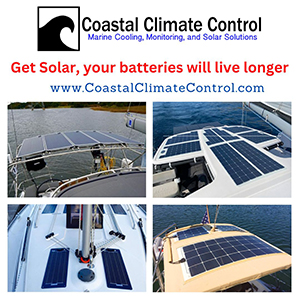
- Media Advertising & Rates
Published by Blue Water Sailing Media, a division of Day Communications, Inc., Middletown, RI
Publisher & Editor: George Day
Blue Water Sailing Media publishes Blue Water Sailing magazine, Multihulls Today and other titles.
Cruising Compass Advertising Sales:
George Day, Newport, RI [email protected] 401-847-7612
© 2014 Blue Water Media. All rights reserved. | Admin
F1x hydrofoils
Ultra-modern, lighter = better, craftsmanship, f1x hydrofoils - design.
Since 2014 the A-Class with our design hydrofoils is the founder of the so-called Z-foil configuration.
Because both foils are inserted downwards, a V-shape is created under water. The A-cat flies above the water on this created lift surface.
The latest generation of Z-foils of the DNA F1x is a design by the designers of Emirates Team New Zealand (ETNZ) and Glenn Ashby .
We build your new foiling boat!
Material & technology.
Base material: All F1x hydrofoils are made of carbon pre-preg. Thanks to our unique ‘one-shot’ production process, we manufacture all our continuous fiber foils, cured under vacuum in our 6.5 x 2.20 meter Autoclave.
The specially developed production method creates a hydrofoil that cures in one go, without any glue joints and including internal stiffening ribs. The result is a super-strong hydrofoil that is as light as possible. All foils are finished with high-quality paint finish. Color of your choice.
Our automated pre-preg cutting machine from the Zünd brand prepares the laminates with high precision. A five-axis milling machine with a working range of 5.5 x 2.5 x 2 meters molds the required tooling fully automatically. All of this in-house.
CHARACTERISTICS F1x HYDROFOIL
The production of the F1x hydrofoils for the A-cat is entirely in the hands of DNA Performance Sailing. We are constantly working on the further development of this super fast foiling catamaran. Besides the latest version DNA F1x, we now also have the DNA F1 Vintage, for the non-foiling group A-class sailors.
Depth: 1.37 m Widest point: 0.16 m Smallest point: 0.05 m Design: Emirates Team New Zealand and Glenn Ashby .
The above specifications refer to the daggerboard foils.
Schrijf je in voor onze nieuwsbrief en blijf op de hoogte van de nieuwste ontwikkelingen!

Contactformulier
- Company Name
- Full name * First Last
- Emailaddress *
- Phonenumber *
- Mijn vraag betreft * My question: TF10 F1x G4 F4 Custom Parts Hydrofoils Other
- Name This field is for validation purposes and should be left unchanged.
Registrieren Sie sich für unseren Newsletter
lassen Sie sich über die neuesten Entwicklungen informieren!
- E-Mail-Adresse *
Schrijf je in voor onze nieuwsbrief
blijf op de hoogte van de nieuwste ontwikkelingen!
- First name *
- Last name *
- Phone This field is for validation purposes and should be left unchanged.
Wij gebruiken cookies om u de beste online ervaring te bieden. Door akkoord te gaan, accepteert u het gebruik van cookies in overeenstemming met ons cookiebeleid.
Wanneer u een website bezoekt, kan deze informatie in uw browser opslaan of ophalen, meestal in de vorm van cookies. Beheer hier uw persoonlijke cookiediensten.
- wordpress_test_cookie
- wordpress_logged_in_
- wordpress_sec

- FlySafe ® Foil Control
- iFLY Reviews
- Our Partners
- Distributors
Class Association
Enter your keyword.
Just enjoy high speed - foiling
” iFLY – Born to FLY “
Just enjoy foiling, ” high performance sailing “, ” we love speed “, ” join the adventure “.

iFLY15 – Technical SPECS
Length 4.63 m, 15 ft..
A Foiling Catamaran for 1-2 person(s) does not need to be any longer than this. The ancient rule that says you need length to achieve speed does not apply, as hulls do not touch the water at most times.
Width 2.50 m.
This width provides plenty of righting moment, still being road legal ato be transported in horizontal position without disassembly.
7.5 m mast / 11.2 sqm mainsail
7.5 m mast with 11.2 sqm deck-sweeper mainsail. – 8.5 m mast on iFLY RAZZOR Pro with bigger rig
Draft: 95 cm
Weight: 90 kg.
90 kg ready to sail. A very light boat, providing nonetheless excellent stability for everyday suitability.
Crew 1-2 - max.180kg
Flysafe® foil control.
T-Foils Main Foils and Rudders FlySafe automatic dynamic foil control Additional Option: Main Foil Differential >>>
Know More >>>
Different - Rig Options
LATEST DEVELOPMENT OF “DECK SWEEPING” MAINSAIL THE ROLLABLE HERU WING RIG LIGHT WIND FORESAIL «CodeF»
Full Carbon Hulls
Looking for the perfect setup for your foiling sailboat.
We can recommend the best iFLY setup and accessories for your boat. Get in touch for the ultimate sailing experience!
Performance
A great number of innovations all over the catamaran and the perfect match of all components allow controlled high-speed foiling experience. iFLY15 is full of innovations, e.g. in hull design, hydrofoils, rudders, automatic flight control system, two-layer wing trampoline, high performance rig…
HULL Design
full carbon – lightweight – performance design: Born to foil
High Performance Rig Options
LATEST DEVELOPMENT OF “DECK SWEEPING” MAINSAIL WORLD PREMIERE: THE ROLLABLE HERU WING RIG : WORLD PREMIERE: LIGHT WIND FORESAIL «CodeF». ALLOWS UPWIND FOILING (as well as other courses/points) ALREADY IN EXTREMELY LIGHT BREEZE. Know More >>>
Two Layer Trampoline
AERODYNAMIC INNOVATIVE WING TRAMPOLINE CREATING LIFT.
Full Carbon T-Foils
SCIENTIFICALLY DEVELOPED high-end foils for early take off, high speed and maximum stability.
flySafe® dynamic foil control system
The foils are controlled independently, dynamically and precisely on both sides by the flySafe® foil control system . This enables high performance sailing through stable flight. The unique foil control system of IFLY15 is a 7 years proven system developed by CEC Catamarans. Know More >>>
IFLY MAIN FOIL DIFFERENTIAL TECHNOLOGY
MDT FOIL CONTROL – iFLY rake control The sophisticated main foil differential is an active flight assistance – The Rake is adjustable while sailing. Advanced Rake Control is for the experienced, performance-oriented Catamaran sailors / pro sailors and is a feature on the iFLY RAZZOR Pro. Know More >>>
Innovations and more >>>
In the hand of the experienced sailor, iFLY15 is a high-performance racing machine. STABILITY IS NOT CONTRADICTORY TO HIGH PERFORMANCE OR SPORTINESS , on the contrary, it is a prerequisite for safe reaching and maintaining constant high speeds. Stable flight allows the sailor to concentrate on the course, on the wind, as well as on opponents and strategy – rather than permanently getting distracted by working on the foiling balance.
EARLY TAKE OFF IN WINDS AS LOW AS 2Bft. / 6 KNOTS , by combining the innovative “KickOff” foil control with a trampoline that provides boost and with the latest generation of rig and foils.
BOAT SPEEDS FAR BEYOND DOUBLE WIND SPEED CAN BE ACHIEVED . Enjoy high speed foiling with top speeds far beyond 25 knots – in ideal conditions up to 30 knots.
CONTROLLED FOILING EVEN IN THE UPPER WIND RANGE BEYOND 22KNOTS OF WIND SPEED – supported by the new FlySafe® Automatic Foil System.
FOILING PLEASURE AND PERFORMANCE ALSO IN CHOPPY WATERS
FREEDOM ! FLYING SOLO OR OPTIONAL WITH CREW . You have the choice. No manhunt for crew. But still enjoy the opportunity of taking a friend or family to fly with you. Up to 140kg of crew weight. (To keep the boat and especially the mast light, we specified the iFLY15 components intentionally not for double trapeze.)
NO HOISTING AND LOWERING OF DAGGERBOARDS while sailing. (Only for beaching or in shallow waters.)
FREEDOM TO SWITCH BETWEEN FLYING MODE OR SAILING AS A CONVENTIONAL CATAMARAN (with at least the leeward hull touching the water). Within seconds iFLY15 can be switched to Non-Flight mode, even while sailing. In that mode, iFLY15 will not take off, but the foils will still create lift and give an extra agile sailing behavior, which is on the same time very stable as rudder Foils will avoid pitch poling. Non-Flight mode is providing additional security in extreme high wind speeds. It is also useful for less experienced sailors or in all situations, where taking off is undesirable (e.g. in the harbor or while towing…).
EASY TO LEARN FLYING BY AVERAGE SKILLED AND TRAINED SAILORS
EASY BEACHING AND SLIPPING , as simple as with any conventional beach catamaran by using a standard catamaran beach trolley. Foils remain flat under the keel, with the daggerboard lifted as on a conventional catamaran.
SIMPLE TO DISASSEMBLE PLATFORM . Width of 2.50m is also road legal in most countries for horizontal transport without disassembly.
DAGGERBOARDS CAN BE PLUGGED IN FROM ABOVE and Foils securely anchored from below with one central screw.
FAST SET-UP OF THE iFLY15 FROM ROAD TRAILER TO SAILING . Simple rigging the mast, no genacker boom, no foresail, no spi.
SILENT AND CALM PLANING ABOVE THE WAVES . Flight height of up to 90cm, avoiding even high waves below.
EASY TO FOIL THE JIBE (without landing). Stable maneuvers are made easier by the fact that the four T-Foils always remain in the water.
« INTERNATIONAL FORMULA 15 FOIL » Class Association. The new development class for FOILING, SINGLE HANDED on MULTIHULLS. Multi manufacturer class in the tradition of a Formula18, A-Class or international Moth. Enables large regatta fields and evolution of the boats, following the technical progress (which is especially essential in the case in Foiling). Strict regulations to avoid uncontrolled exaggerated development.
Contact : [email protected]
Catamaran Europe Central
The iflysail team, is looking forward to your message, more to know about ifly foiling , interesting tech, high performance rig options >>>, flysafe® dynamic foil control system >>>, ifly main foil differential technology >>>.
MDT FOIL CONTROL – iFLY rake control
News and More
Ifly foiling experience >>>, press articles >>>, events >>>.
Our Catamarans
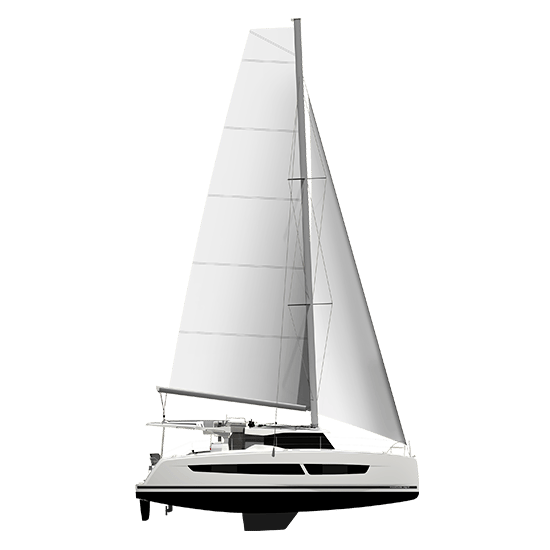
Explore our models in a different way thanks to the virtual marina
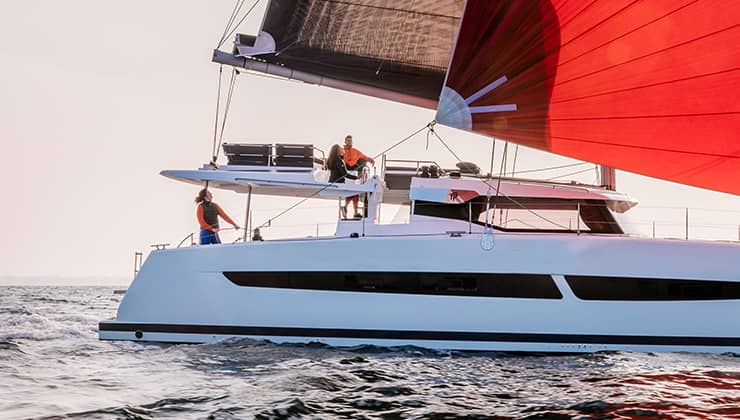
Efficiency through design
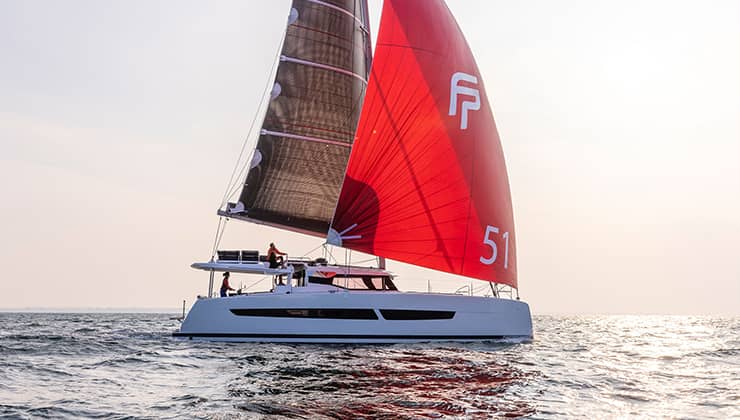
A feel for the sea: sailboats first and foremost
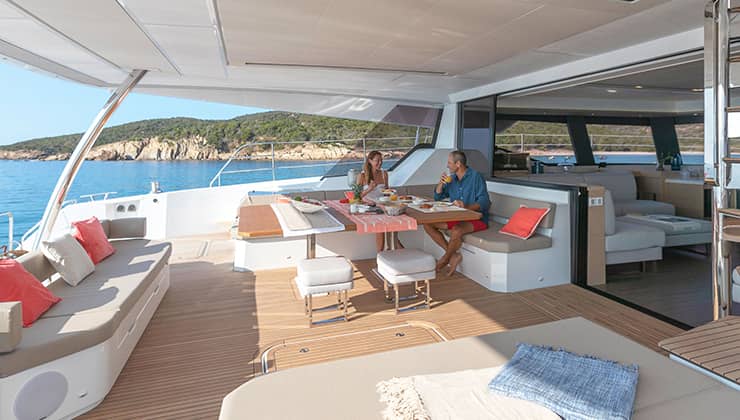
When volume transforms to real space
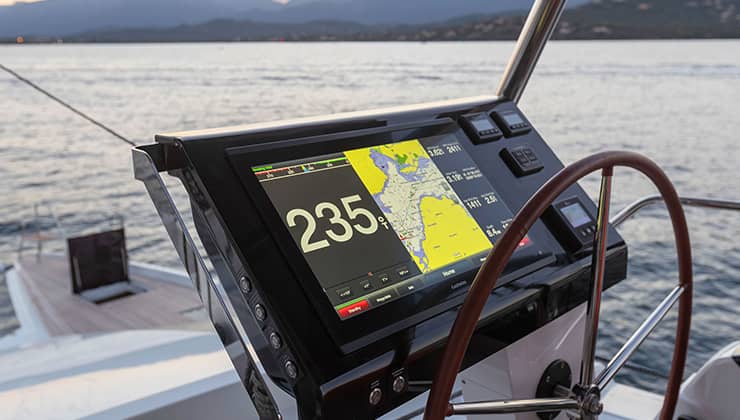
Innovation as a foundation
- Smart Electric
- Virtual marina
- Experiences
LAUNCHING a new generation of catamarans
10 September 2024
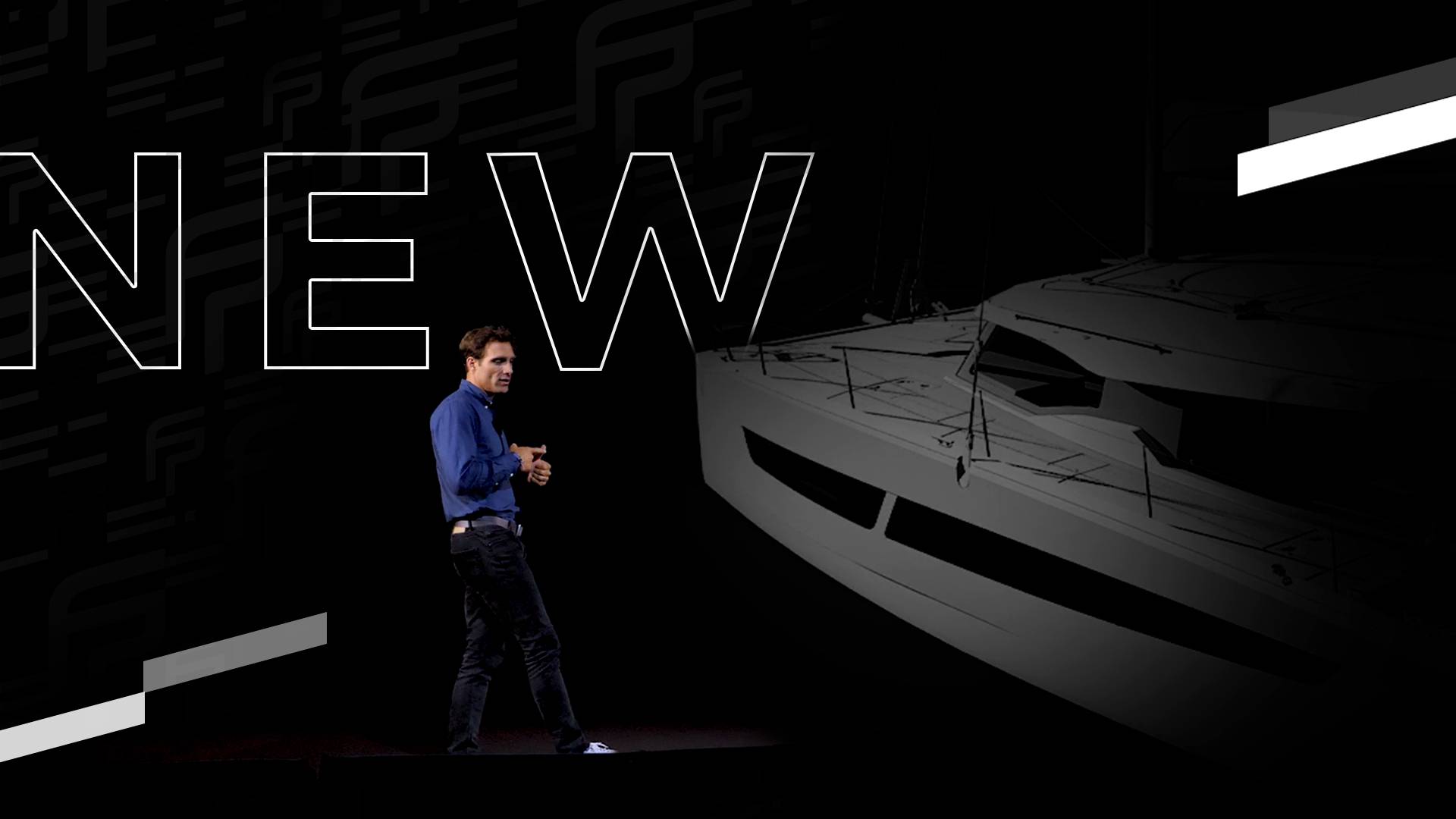

Discover in a new format video the 2025 new model and the vision of the Fountaine Pajot Shipyard
Romain Motteau, Managing Deputy CEO of Fountaine Pajot, share with you an exclusive preview of the brand new generation of Fountaine Pajot Sailing Catamarans🚩
“Since 1983, our unique know-how has enabled us to meet today’s challenges while preparing for the future. Fountaine Pajot reaffirms the promise of an art of living through the pleasure of sailing . With a vision focused on eco-responsibility, we want to offer you a brand new sailing experience in harmony with three sustainable energies : the sun, the wind and the ocean.”
The brand new generation of Fountaine Pajot catamarans starts now!

Video | A new generation of cruising catamarans
Discover our new catamaran HERE
After seeing the video of Fountaine Pajot’s new sailing catamaran , click on the link below to find out more about this spacious, modern and highly innovative new model!
You may also be interested in
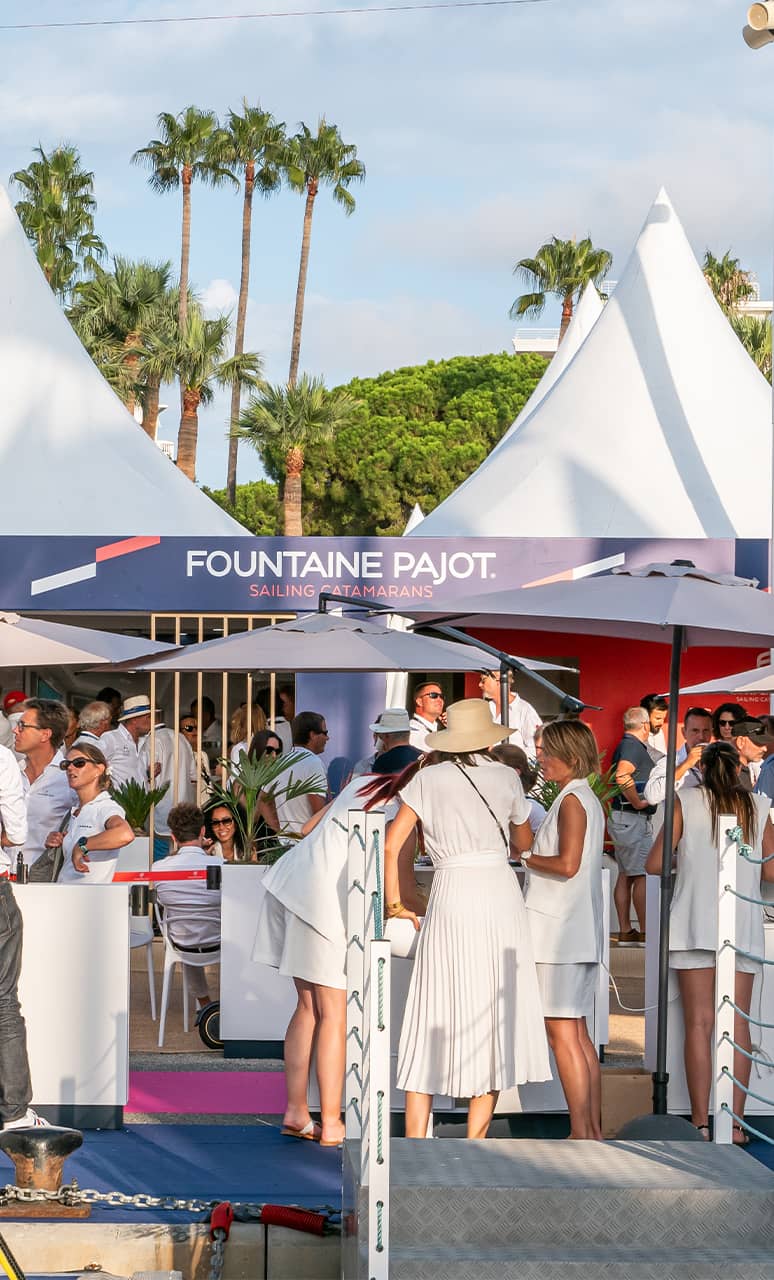
06 Sep 2024
A real showroom afloat signed FOUNTAINE PAJOT

02 Sep 2024
A step ahead for Fountaine Pajot
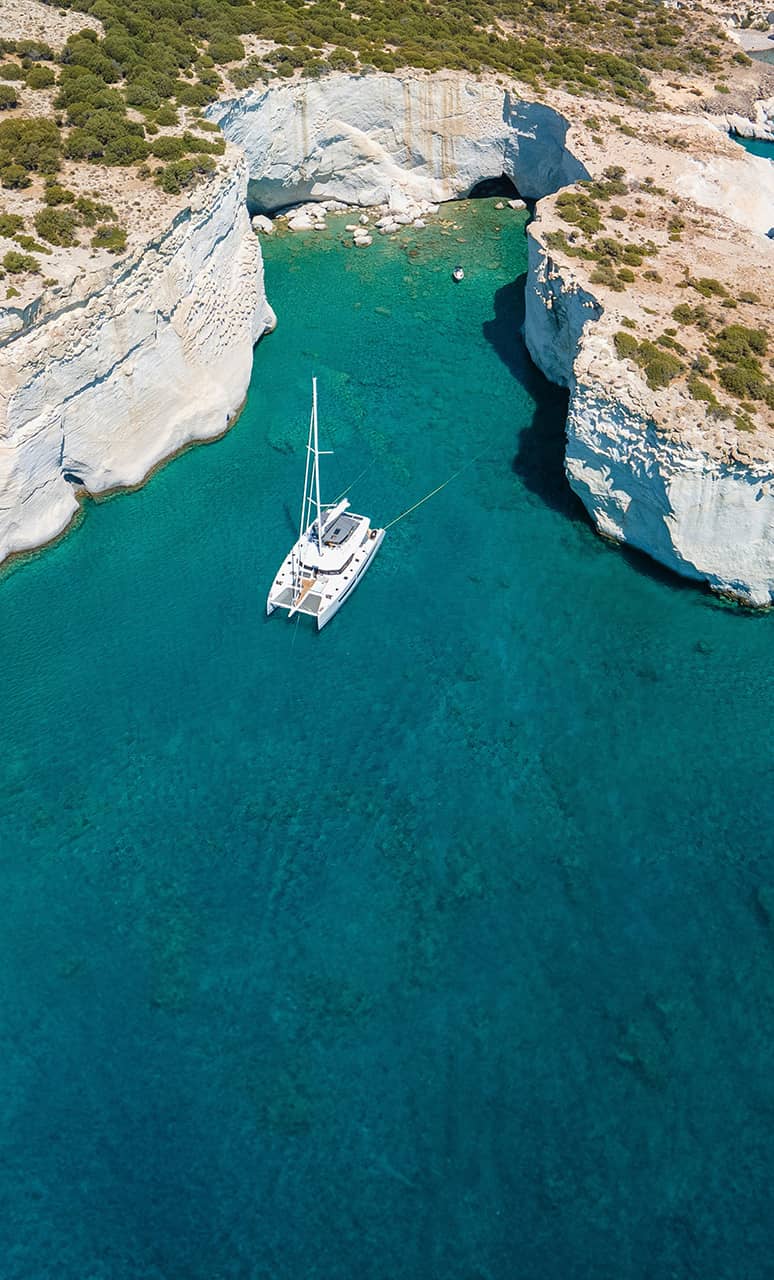
17 Jul 2024
Fountaine Pajot team wishes you a great summer!
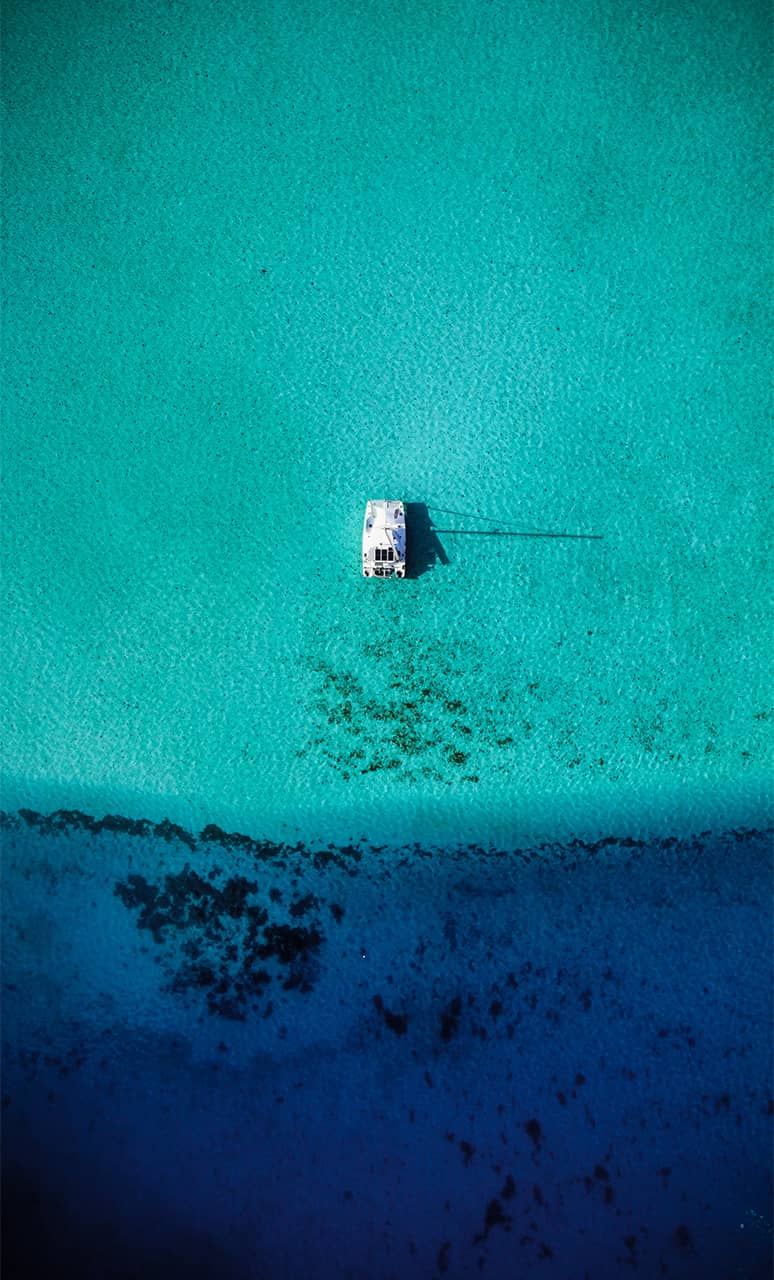
10 Jul 2024
New 2024 edition of the MyBoatAndI photo contest
Interview with an Alégria 67 Owner & guided tour
Xavier Embroise
Alégria 67 Owner
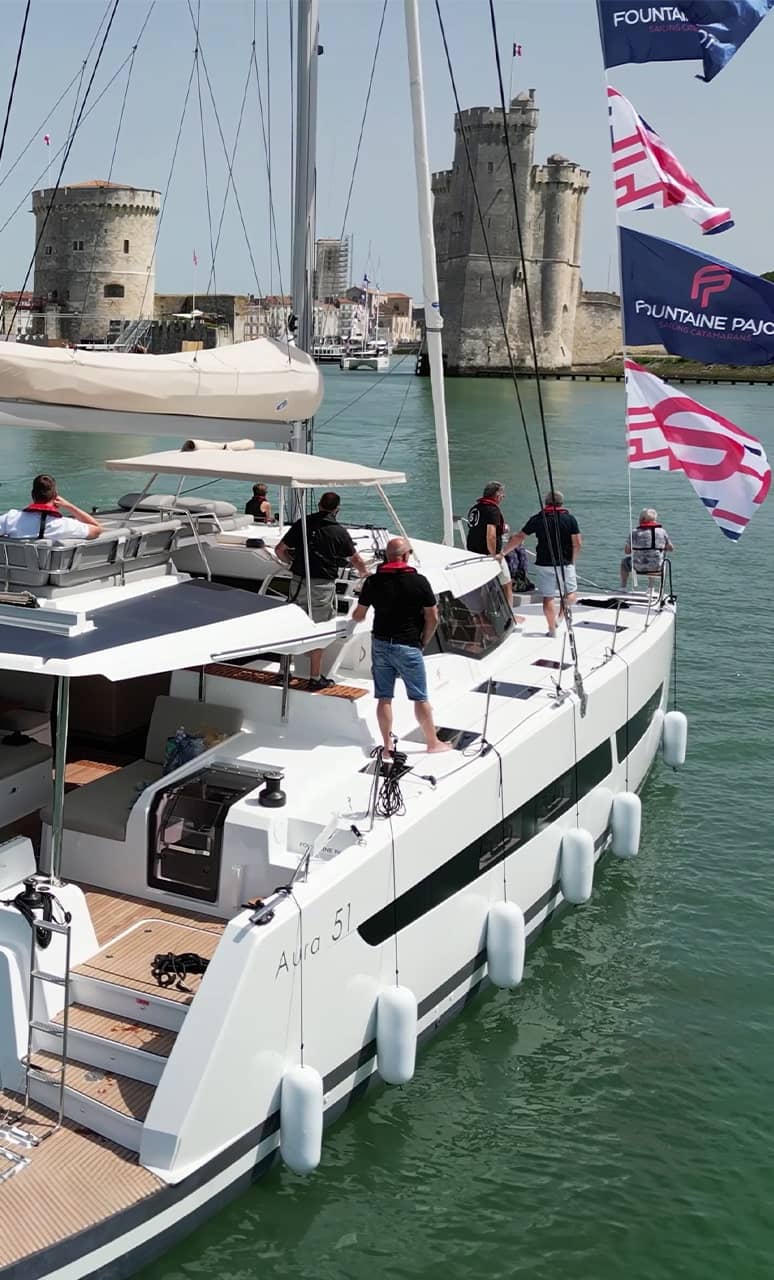
02 Jul 2024
3 exceptional days to discover the Fountaine Pajot Sailing Catamarans range
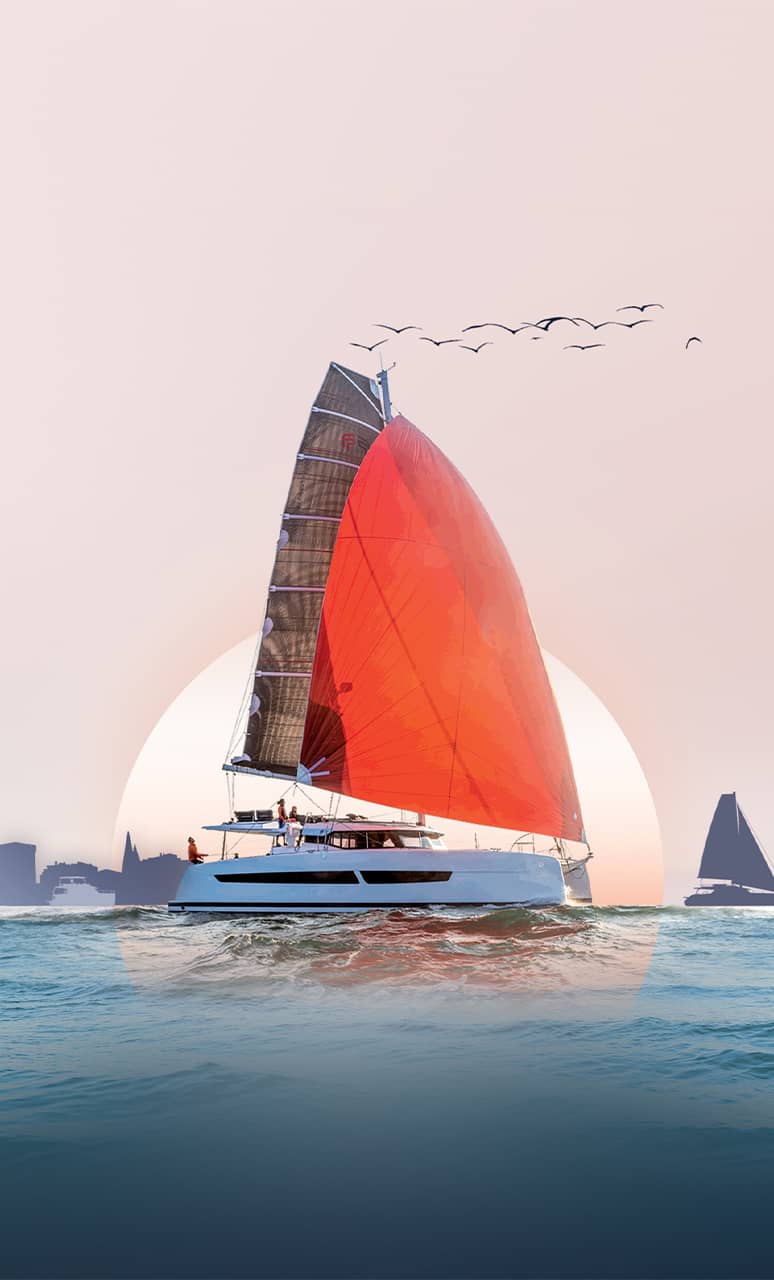
22 May 2024
International Event | Open Days La Rochelle

03 May 2024
Tanna 47 | Exclusive testimonial for a Mediterranean circumnavigation
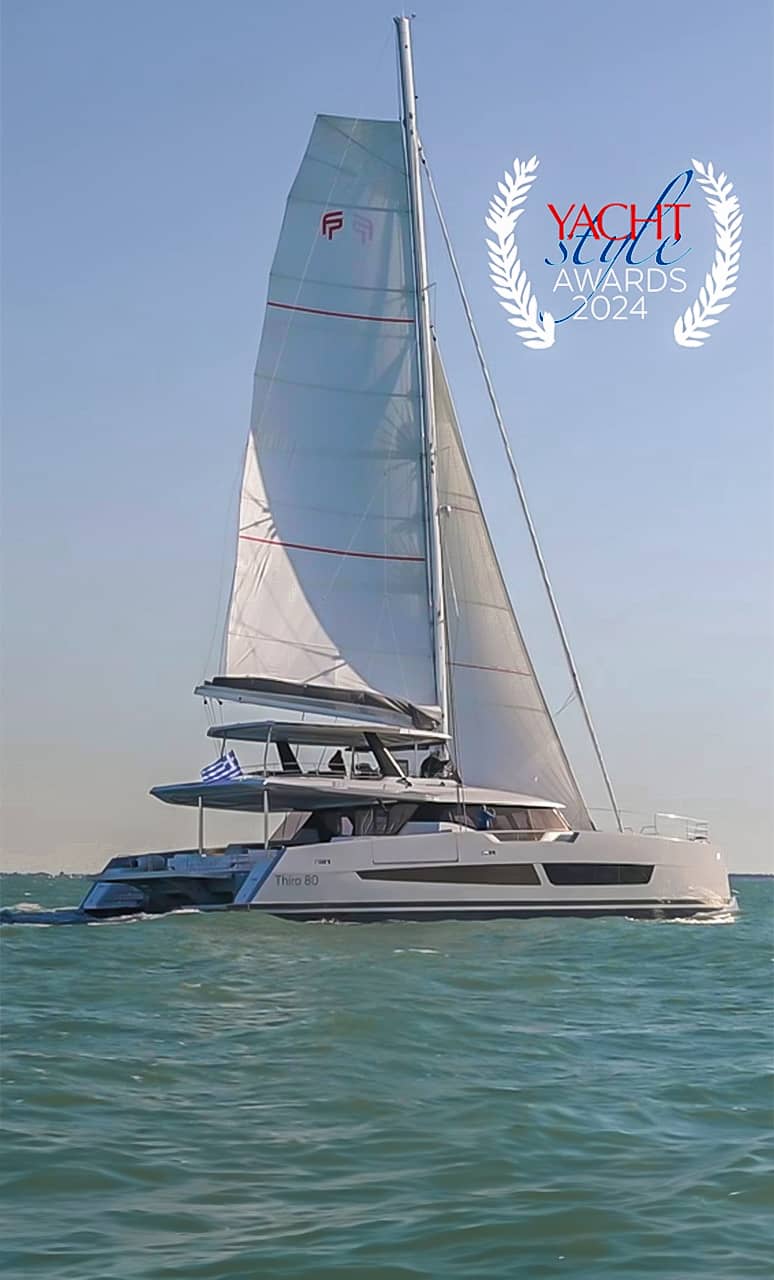
24 Apr 2024
Thíra 80: voted “Best Production Sailing Catamaran” by Yacht Style
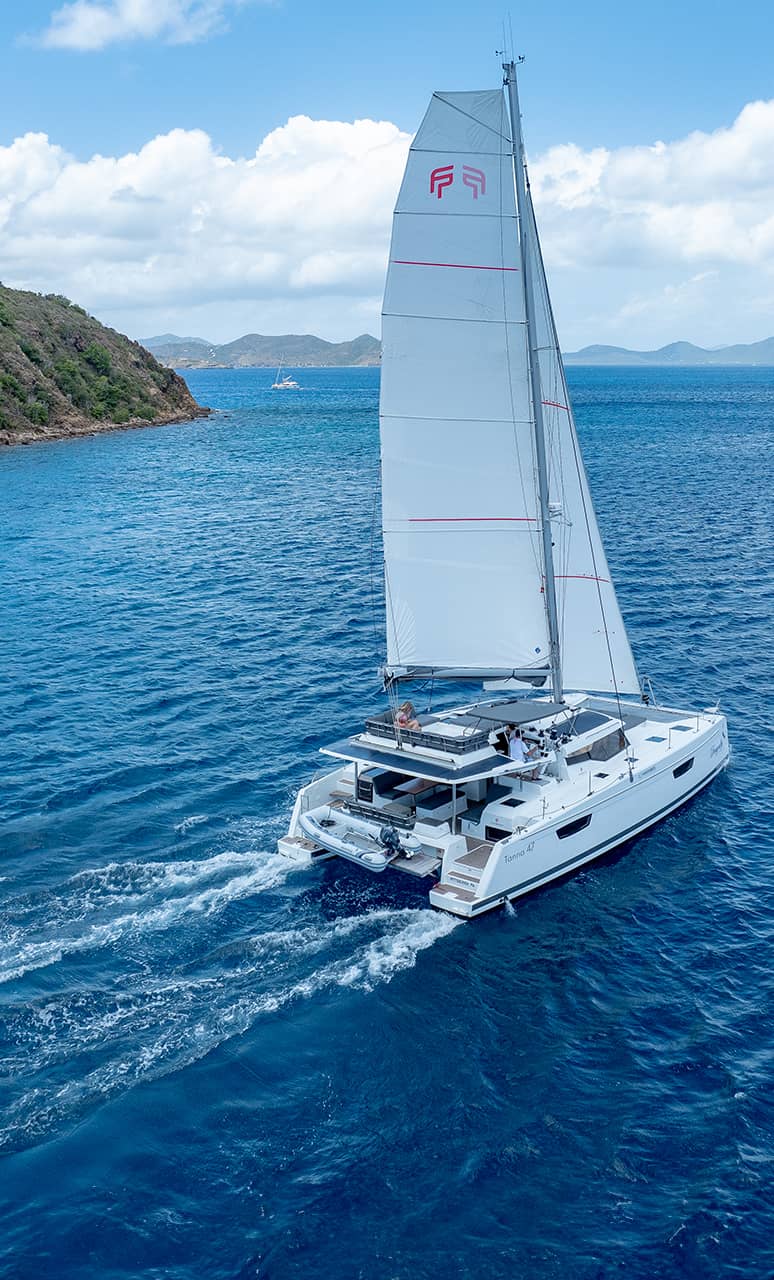
22 Apr 2024
Come and meet Fountaine Pajot on the docks of the Mediterranean sea
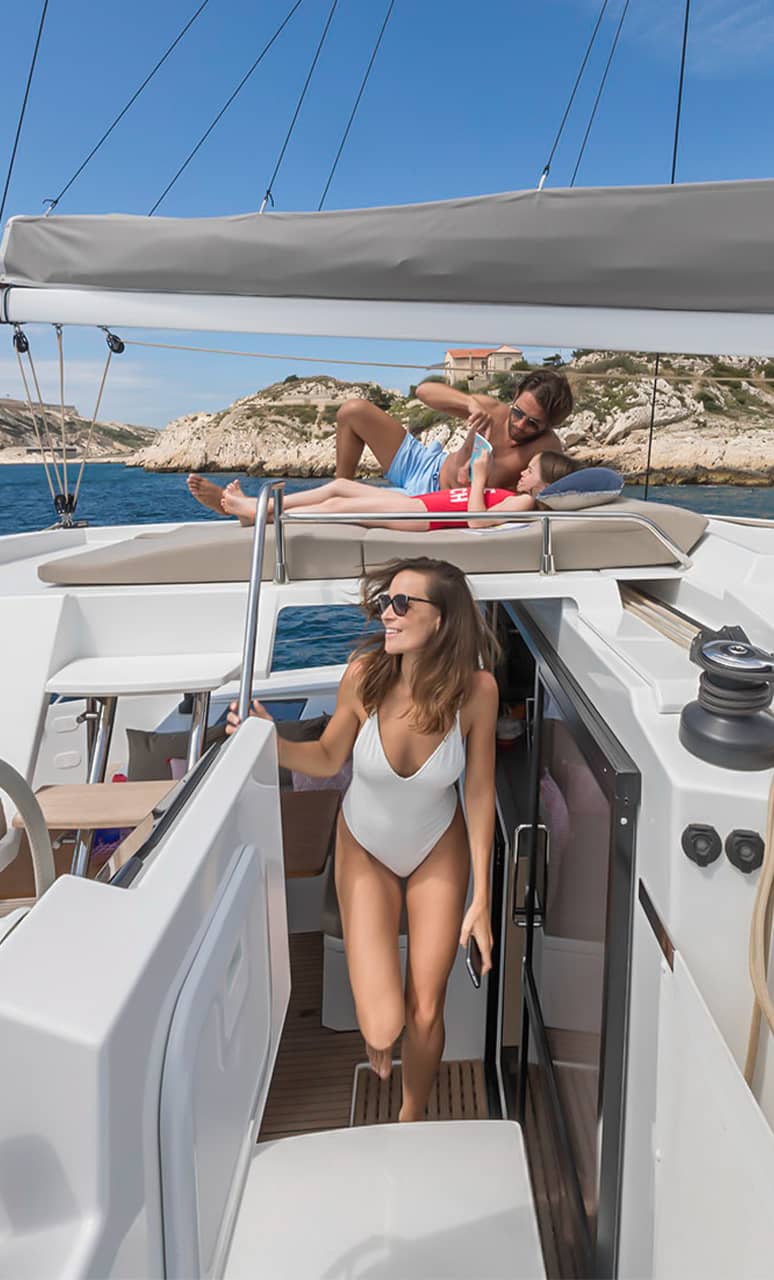
04 Apr 2024
Sailing towards the Horizon with the Astréa 42 Cruising Catamaran by Fountaine Pajot
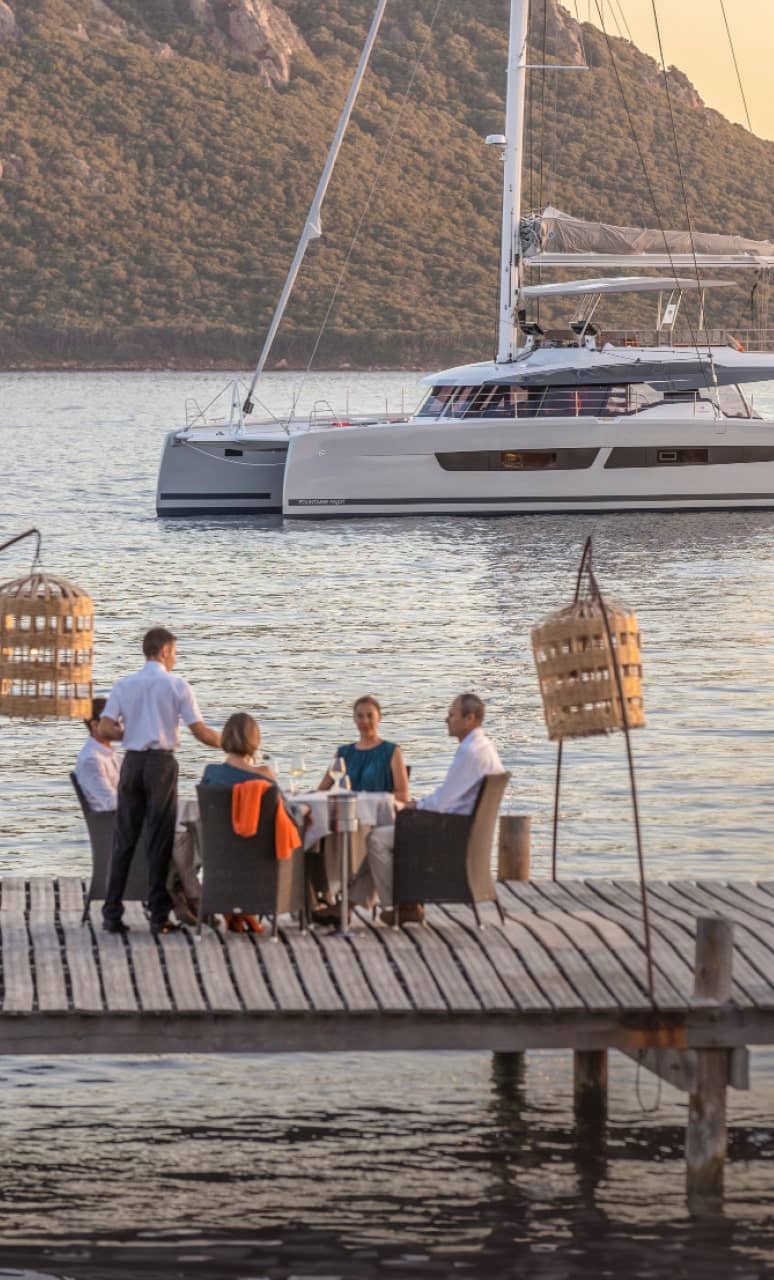
08 Mar 2024
Alégria 67 – The Flagship Catamaran Star at the International Multihull Show – La Grande-Motte
Subscribe to the newsletter
Follow the adventures of Fountaine Pajot Owners, discover the latest news and upcoming events, and take part in the development of the Boat of tomorrow!
Compare models
Catamaran New 41
Catamaran Astréa 42

Hosting capacity
Motorisation
Technical information
User-friendly areas
Sunbathing Oui
Kitchen Non
Discover the prices
Double rooms
Your contact details
One last step before reaching the next page & discovering the prices proposed & main options for this version! You'll then be able, to schedule a live chat with your local dealer to discuss all the options and configurations available for this model!
Your home port
Any questions?
No pack information currently available online for this Flagship model. We will get back to you directly. Thank you
Would you like to configure this model’s options or set up another model?
Make an appointment with your nearest dealer and choose the boat of your dreams.
@media screen and (min-width: 70em){.css-1c47y9x{color:var(--chakra-colors-blue\.brand);}} New Cat F1 buy/sell second hands, ads and prices
New Cat F1 short Description
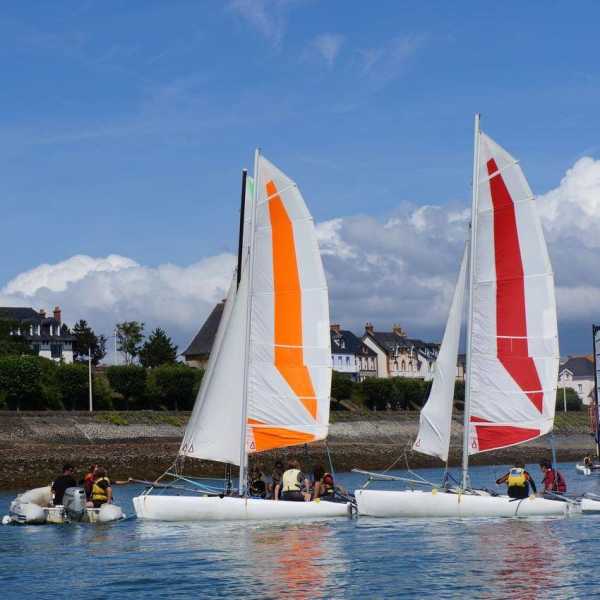
the last New Cat F1 ads at the best price

New Cat F1 Erplast for sale in Lacapelle-Viescamp

New Cat F1 New Marine for sale in Mauges-sur-Loire

New Cat F1 sails for sale in Mauges-sur-Loire
New Cat F1 presentation
Some figures of the new cat f1 catamaran :.
Min price :
Max price :
Average price :
Median price :
Available boats :
Used New Cat F1 price table
| Advert title | Builder | Year | Price |
|---|---|---|---|
|
| Erplast | 2002 | 350€ |
| New Marine | 2007 | 500€ |
| New Marine | 2000 | 380€ |
| - | 2000 | 140€ |
- THE PRINCESS PASSPORT
- Email Newsletter
- Yacht Walkthroughs
- Destinations
- Electronics
- Boating Safety
- Ultimate Boating Giveaway

Discover the Top Power Catamarans for 2024
- By Yachting Staff
- Updated: September 10, 2024
Power catamarans have seen a surge in popularity, growing both in size and appeal. These cruise-focused yachts offer homelike comfort, fuel efficiency and user-friendly operation, making them a favorite among avid travelers. Their popularity extends to the bareboat charter market for the same reasons.
In this article, we explore the world’s top power catamarans, ranging from a 36-footer ideal for a cruising couple to a 78-footer perfect for entertaining friends and family. The propulsion options are diverse, including outboards, diesel inboards, hybrids, and even all-solar setups.
Top Luxury Power Catamarans
The following power catamarans are all vessels we’ve reviewed. They are listed in no particular order.
- Fountaine Pajot MY44 : A family-oriented cat suitable for long-range cruising and aimed at owner-operators.
- Silent Yachts 60 : This is a catamaran that can cruise comfortably for long distances using emissions-free solar-electric propulsion.
- Horizon PC74 : With interior and deck space like a much larger vessel, the PC74 is perfect for cruising the Bahamas and Caribbean.
- Aquila 36 : This beefy 36-footer is an outboard-powered, express-cruiser-style catamaran.
- Lagoon Seventy 8 Powercat : A spacious design, this vessel fits the volume of a 130-foot-long monohull into just 78 feet of length overall.
- Horizon PC68 : This cat has a stable ride, long range, volume to spare and intriguing layout options.
- Two Oceans 555 : An elegantly simple yet luxurious 55-foot custom with the space and amenities of a much larger vessel.
- Lagoon 630 : From its open salon to its spacious decks, the Lagoon is a comfortable and luxurious platform.
- Fountaine Pajot MY5 : A midsize cruiser with serious big-boat space for family and friends.
- Prestige Yachts M8 : The voluminous 65-footer lets owners customize onboard spaces.
- Aquila 47 Molokai : Calling all anglers: This cat has 60-plus-knot speed and is set up for serious bluewater adventure.
Fountaine Pajot MY44
The Fountaine Pajot MY44 , a creation of Italian architect Pierangelo Andreani and French designer Daniel Andrieu, has a main deck that’s open from the aft-deck seating all the way forward to the starboard helm station. The sense of spaciousness is significant, for several reasons. First, four glass panels aft can all slide to port, creating an indoor-outdoor space with the aft deck and salon. In the salon, 32-inch-high windows extend for 12 feet down the sides of the yacht, with three sections per side, bringing in natural light along with the three forward panes that comprise the windshield. Finally, 6-foot-6-inch headroom provides vertical clearance, with a 21-foot-7-inch beam that adds interior roominess while keeping the yacht stable.
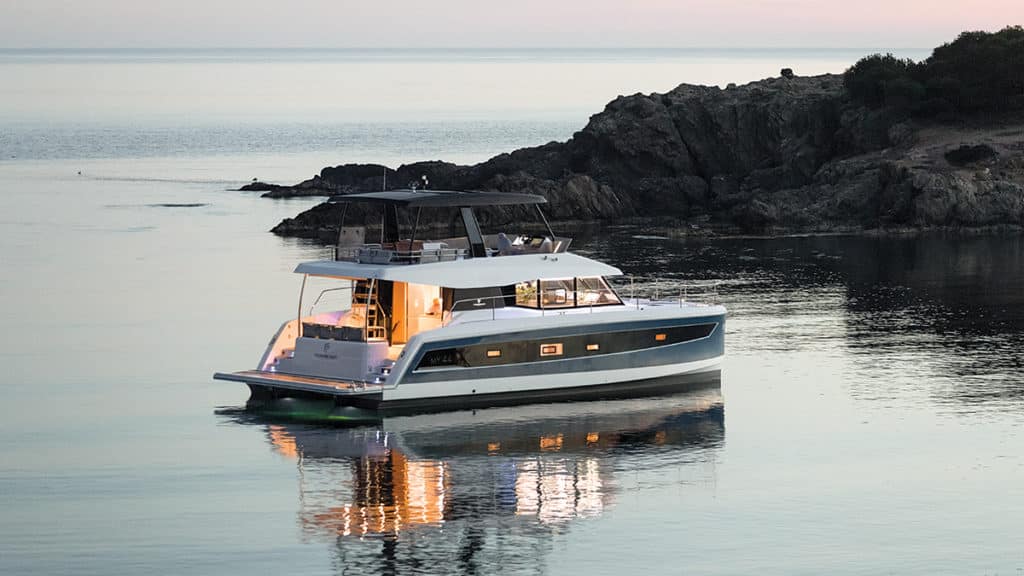
Quick Specifications
| 44’ | |
| 21’5” | |
| 530 gal. | |
| 184 gal. | |
| 6’6” | |
| 32,850 lb. |
Silent Yachts 60
Solar panels, ocean-crossing range and self-sufficiency define the electric Silent-Yachts 60 power catamaran. If there was any question that the “Tesla moment” has arrived in yachting, the Silent 60 clearly provides a positive response. Consider, for a moment, crossing oceans in silence at 5 to 6 knots without consuming a drop of fuel and never needing to plan your course between fuel stops. Imagine sitting at anchor and running the air conditioning all night, not to mention all the galley appliances plus the washer-dryer, without the hum or fumes from a genset.
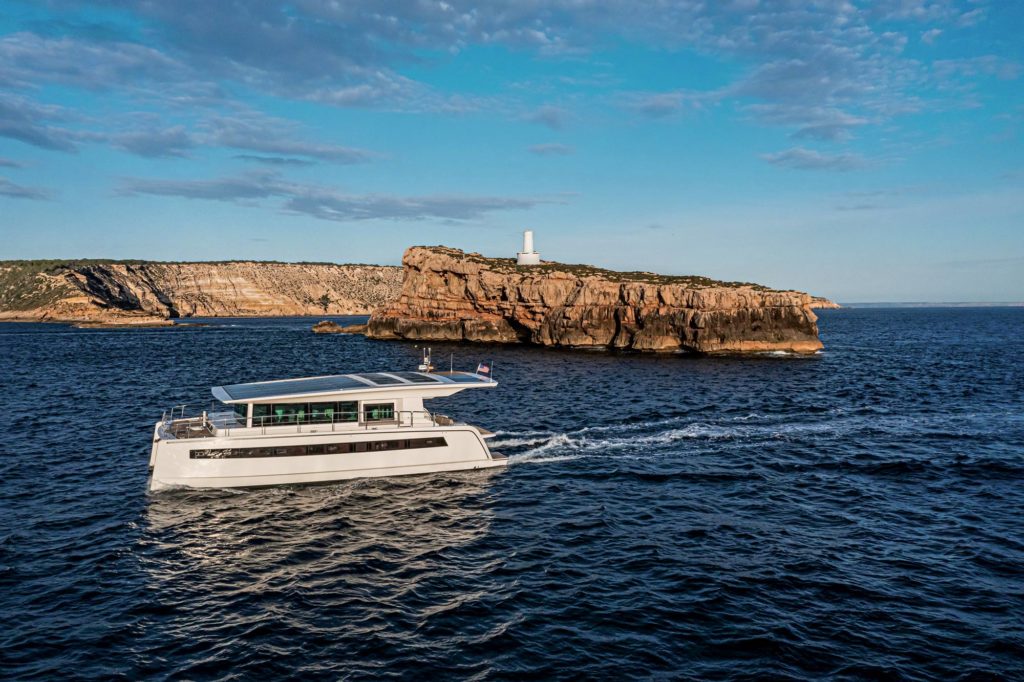
| 62’ | |
| 29’6” | |
| 4’5” | |
| 68,000 lb. |
Horizon PC74
As founder and director of The Powercat Company, a Horizon Power Catamarans distributor, Stuart Hegerstrom had long believed that catamaran builders needed to design their yachts to more stylish standards.
“The boats were very boxy,” he says, based on his years of experience with cats in the charter market. He and his partner, Richard Ford, asked Horizon to produce models that had high-end finishes and looked good inside and out.
The Horizon team brought in mega-yacht designer JC Espinosa to work with its own craftsmen. The result aboard the Horizon PC74 is a catamaran with exterior styling, layout and functionality that should appeal to private and charter owners alike.
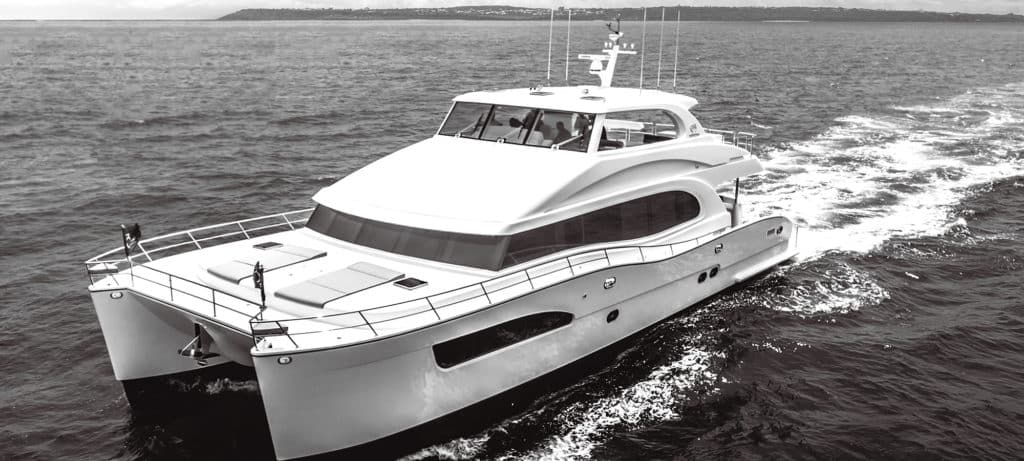
| 73’9” | |
| 28’3” | |
| 2,000 gal. | |
| 400 gal. | |
| 6’ | |
| 163,140 lb. |
The Aquila 36 is a departure from her sisterships in that she is an outboard-powered, express-cruiser-style catamaran, but she also adheres to MarineMax’s philosophies.
With a single main living level from bow to stern and a beam of 14 feet 7 inches, the Aquila 36 is like a bowrider on steroids. She has seating that can handle 20 adults for outings and barbecues, and there are two staterooms below, one in each hull, for family weekending. The staterooms have nearly queen-size berths, en suite heads, stowage and 6-foot-6-inch headroom.
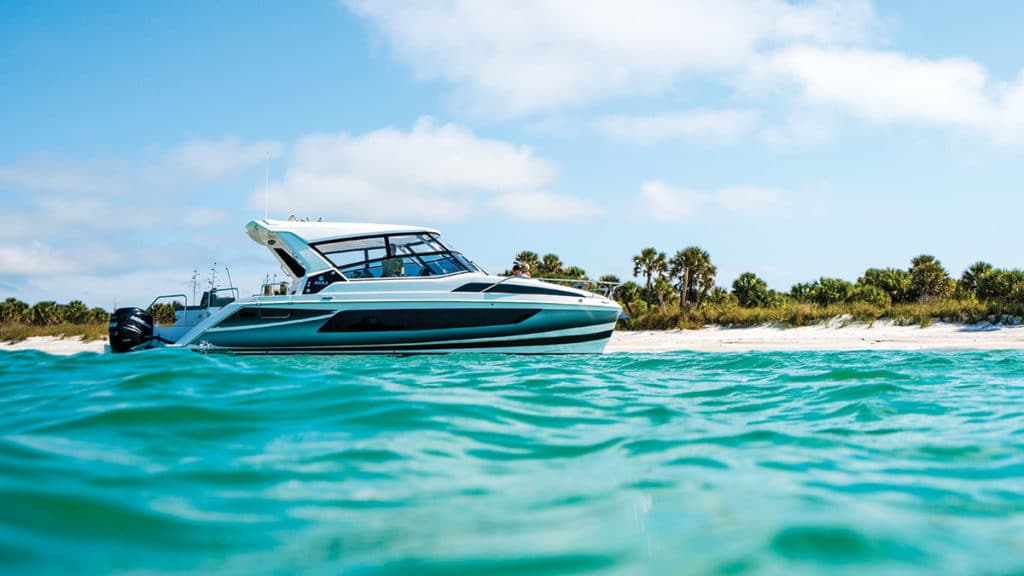
| 36’ | |
| 14’7” | |
| 356 gal. | |
| 200 gal. | |
| 2’ (engines trimmed up) | |
| 21,572 lb. |
Lagoon Seventy 8 Powercat
Lagoon is a division of Groupe Beneteau, the world’s largest builder of sailing yachts, and the Lagoon Seventy 8 Powercat is a developmental sistership of its Seventy 7 super sailing cat. The Seventy series yachts are built at Construction Navale Bordeaux in France, which had to add a new yard to construct these catamarans because they require separate stern molds for the power and sail versions.
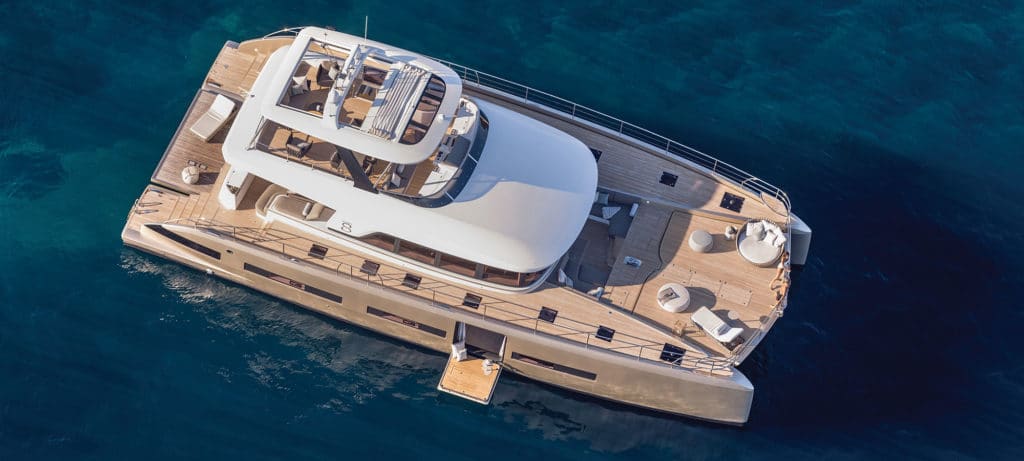
| 78’1” | |
| 36’1” | |
| 2,246 gal. | |
| 422 gal. | |
| 4’2” | |
| 131,153 lb. |
Horizon PC68
Multihull yachts ride differently than monohulls, often counteracting the sea’s motion for a smoother, more stable ride. On the Horizon PC68 , sharp hull entries make head seas seem gentle, and a Humphree stabilization system with blades reduces roll. Horizon uses SCRIMP construction for resin saturation that maximizes strength with an 111,112-pound displacement. And with a 5-foot-4-inch draft, the PC68 invites island cruising.
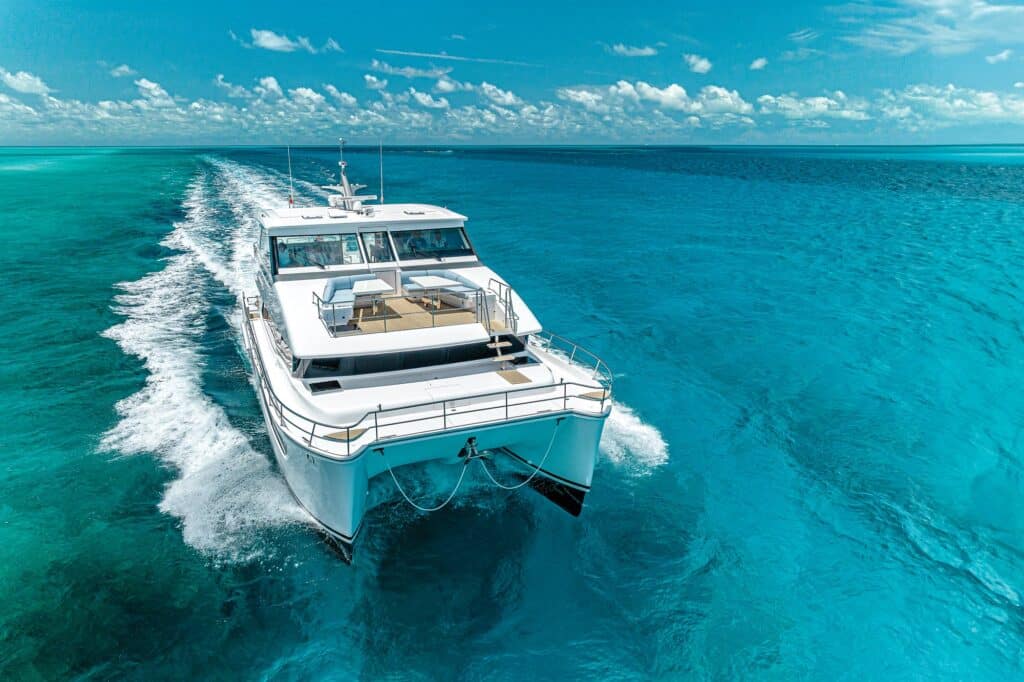
| 60’9” | |
| 24’6” | |
| 1,000 gal. | |
| 250 gal. | |
| 4’9” | |
| 83,467 lb. |
Two Oceans 555
With 27-knot speed, house-like volume, an on-deck master and top-tier tech, the Two Oceans 555 is a formidable power catamaran. Dave Jirikovic of HMY Yachts was on a quest. The sales broker was looking for the meanest, nastiest patch of Gulf Stream he could find to show a potential client what the Two Oceans 555 power cat could handle. And just as he had intended to show us, the broad-shouldered power cat didn’t even notice. He even dropped the single-lever throttles back to idle and left the 25-foot-wide Two Oceans 555 beam-on to another set of square-edged seas. The 55-footer brushed that off too. Jirikovic tried quartering into the seas—never a happy angle for catamarans—and the yacht drowsed through them.
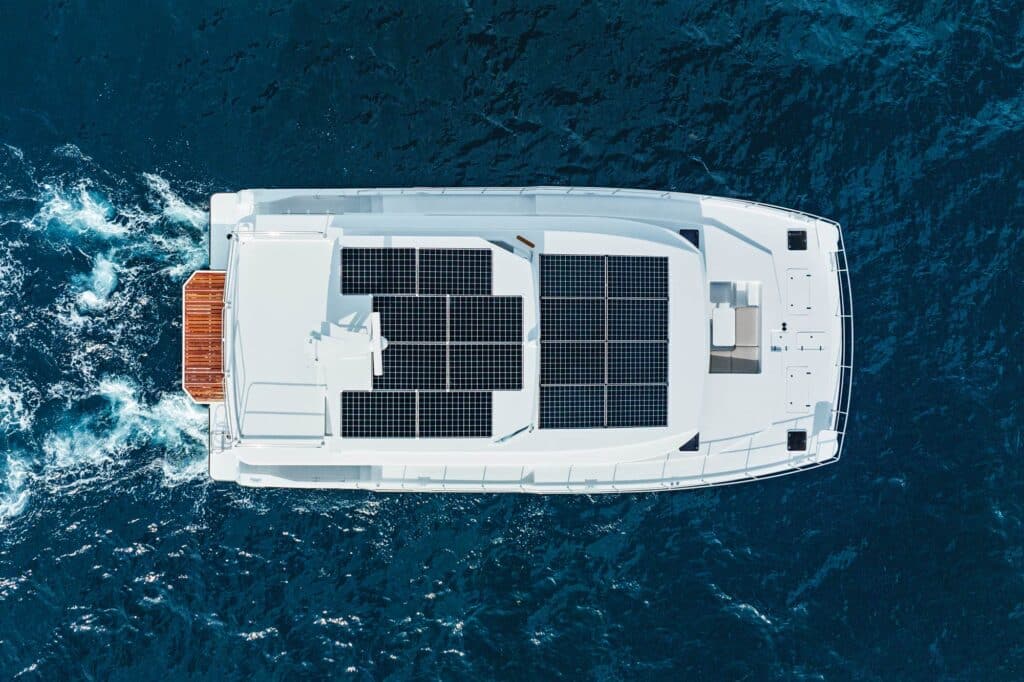
| 55’6” | |
| 25’ | |
| 750 gal. | |
| 200 gal. | |
| 49,600 lb. |
Fitted with the optional twin 300-horsepower Volvo Penta D4 diesels, the Lagoon 630 MY burns only 1.64 gph total at 6 knots, giving a theoretical range of 2,952 nautical miles with standard tankage of 793 gallons. Hull No. 1 had an optional 502-gallon tank, giving it transatlantic range.
Luxury, stability and economy are all hallmarks of Lagoon’s return to luxury motor yachts. If you can take a ride, it will be worth your time.
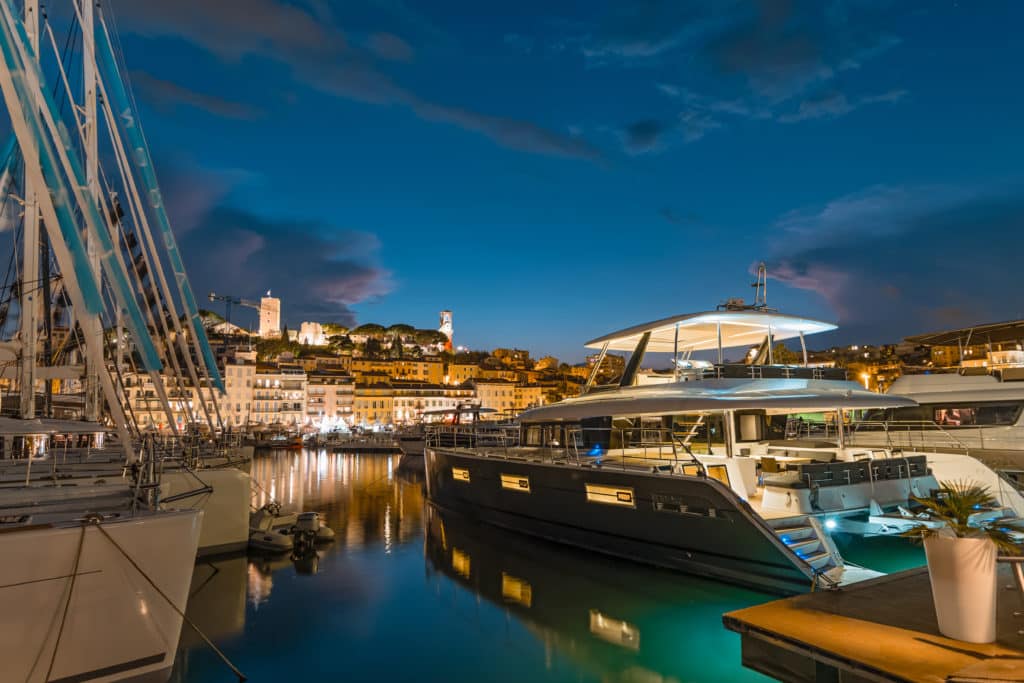
| 64’ | |
| 32’10” | |
| 793 gal. | |
| 254 gal. | |
| 3’11” | |
| 70,097 lb. |
Fountaine Pajot MY5
The flybridge deck on the Fountaine Pajot MY5 is a standout feature, offering virtually unobstructed 360-degree ocean views and an elevated beach club vibe. Aft of the off-center starboard helm is a spacious area perfect for entertaining, complete with a wet bar, refrigeration center, and ample seating. It’s the most popular space aboard according to the builder. And if the weather turns for the worse, a second helm station in the saloon allows the skipper to pilot the MY5 in climate-controlled comfort.
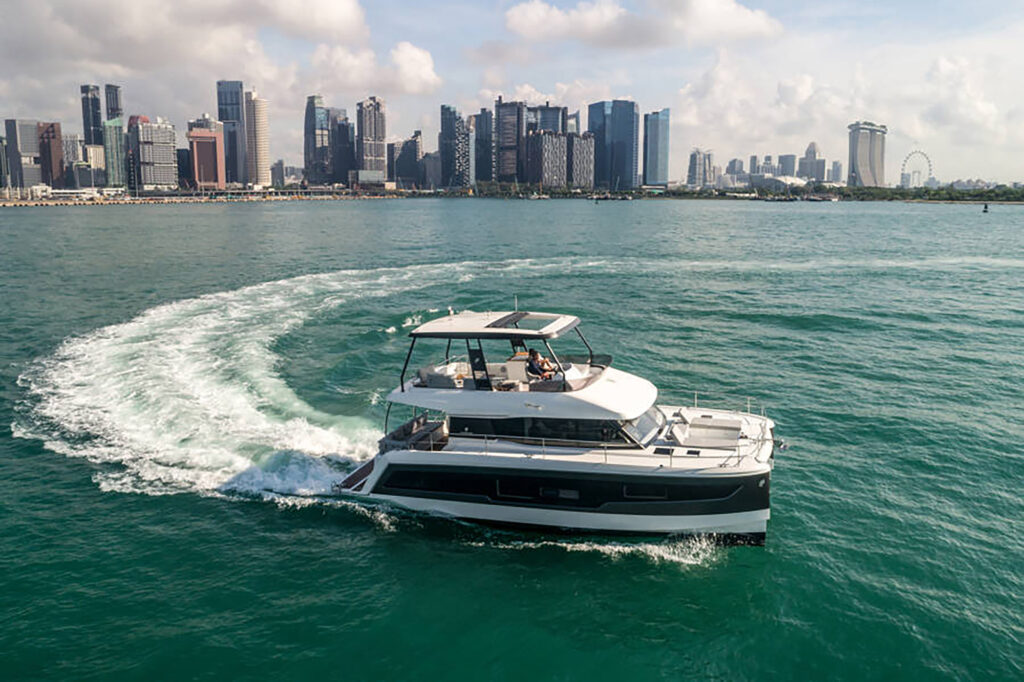
| 42’4” | |
| 19’9” | |
| 372 gal. | |
| 112 gal. | |
| 3’7” | |
| 46,000 lb. |
Prestige Yachts M8
How fitting it was that Prestige Yachts introduced its new M-Line flagship, the M8 , at Portopiccolo, a picturesque yachting village outside Trieste, Italy. Formerly a quarry, the cliff-side area had been chiseled into a clean site rife with eye-catching vistas, much like the French builder’s 65-foot power catamaran and its nearly 3,000 square feet of usable real estate.
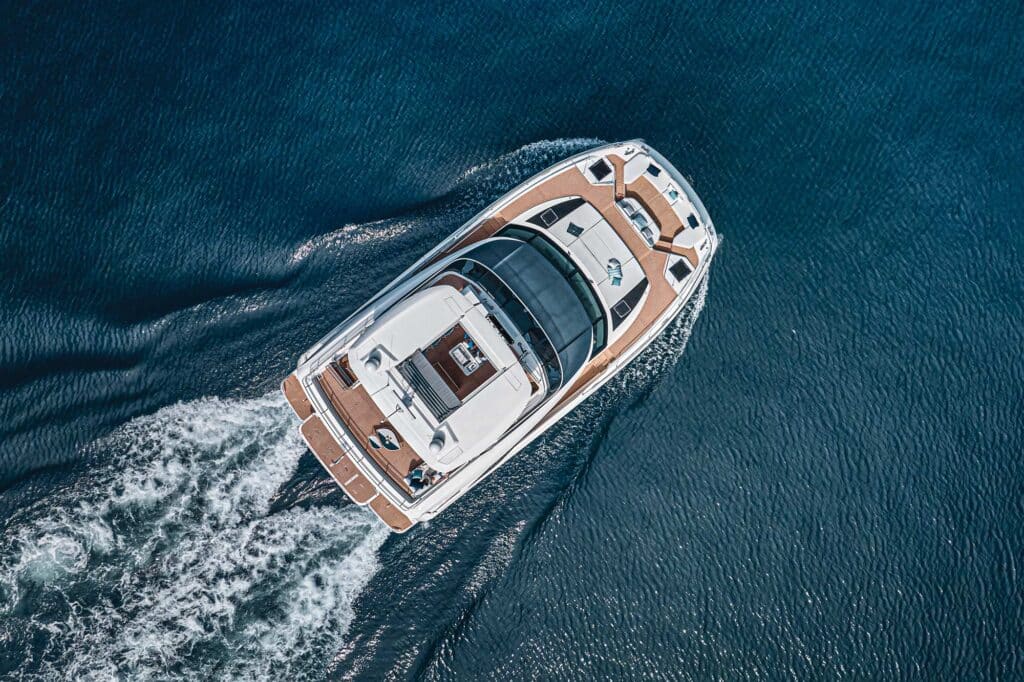
| 65’ | |
| 29’ | |
| 978 gal. | |
| 224 gal. | |
| 5’5” | |
| 98,379 lb. |
Aquila 47 Molokai
With every boat, there’s an origin story. In the case of the Aquila 47 Molokai power catamaran, it starts with MarineMax, which saw people renting boats for bareboat charters. MarineMax Vacations was born. After experimenting with several production yachts, the company decided to build its own: the Aquila line, designed for charter as well as for sale to owner-operators.
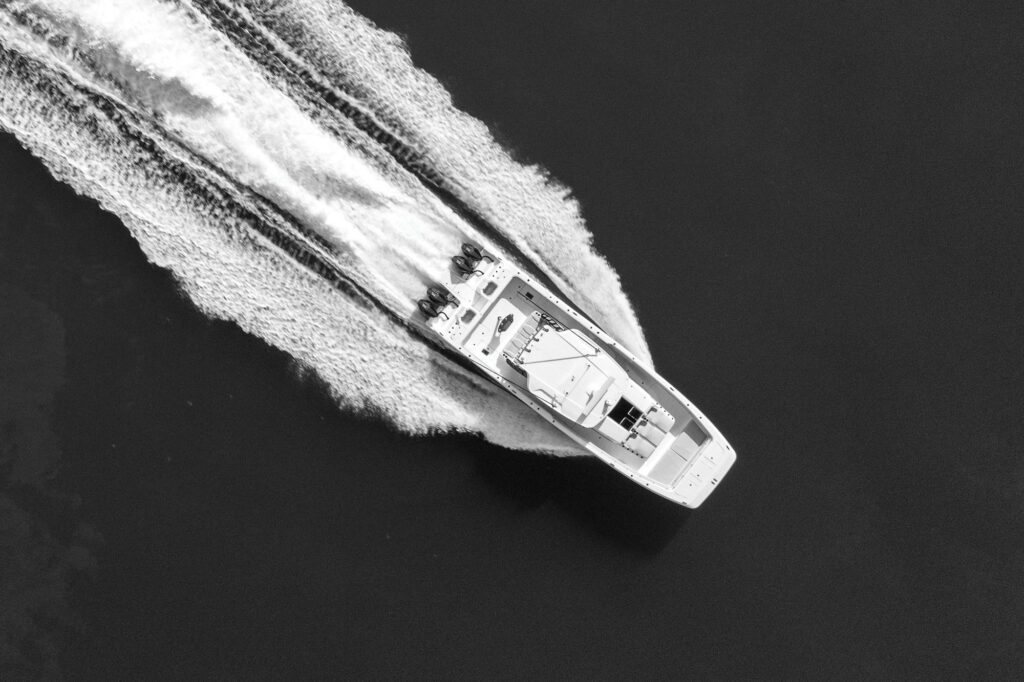
| 49’4” | |
| 14’7” | |
| 1,048 gal. | |
| 2’2” (engines trimmed up) | |
| 22,818 lb. |
- More: Aquila Boats , Fountaine Pajot , Horizon Power Catamarans , Lagoon , Lagoon Catamarans , Power Catamarans , Prestige Yachts , Silent-Yachts , Two Oceans , Yachts
- More Yachts
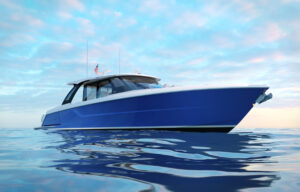
Coming Next Year: Tiara Yachts 56 LS

Top Nine Fishing Tenders For 2024

First Look: Meet the Apreamare 88 Motoryacht Flagship

Holterman Shipyard Debuts Xtreme X-65

Have it Today: 1997 Hatteras 116 For Sale

Cruising into Adventure: Discover Nantucket

Unique Design: 2021 Downeast 54-foot Custom For Sale

- Digital Edition
- Customer Service
- Privacy Policy
- Terms of Use
- Email Newsletters
- Cruising World
- Sailing World
- Salt Water Sportsman
- Sport Fishing
- Wakeboarding
672 Wine Club
- Motorcycles
- Car of the Month
- Destinations
- Men’s Fashion
- Watch Collector
- Art & Collectibles
- Vacation Homes
- Celebrity Homes
- New Construction
- Home Design
- Electronics
- Fine Dining
- Benchmark Wines
- Brian Fox Art
- Disneyland Resort
- Raffles Hotels & Resorts
- Sports & Leisure
- Health & Wellness
- Best of the Best
- The Ultimate Gift Guide
This New Solar-Electric Catamaran Comes With a Massive, Fold-Down Beach Club
The cosmopolitan 125 can cruise the seas with zero emissions, too., rachel cormack.
Digital Editor
Rachel Cormack's Most Recent Stories
- LVMH Could Become a Major Sponsor of Formula 1
- Rolex Is the Go-To Brand for First-Time Watch Buyers, New Data Shows
Axopar Just Unveiled Two Electric Boats Capable of Reaching Thrilling Speeds
- Share This Article

Cosmopolitan Yachts just unveiled an electrifying new catamaran .
Related Stories
This new 72-foot yacht’s new hybrid propulsion system is the first of its kind.
- This Electric Hypercar Just Set the Laguna Seca Lap Record by Accident
- Legendary Formula 1 Car Designer Adrian Newey Is Joining Aston Martin

Described as a floating haven by Cosmopolitan, the multihull has an impressive interior volume of 500 GT and offers nearly 6,500 square feet of deck space. The living quarters are replete with “state-of-the-art amenities and luxurious finishes,” according to the yard.
The spacious layout includes four VIP guest cabins, one owner’s suite with a private terrace, three crew cabins, and a captain’s cabin. The guest accommodation is spread across the lower and main decks, while the owner’s cabin can be positioned on either the main deck or the bridge deck. The crew quarters are located on the lower deck, along with the crew mess, galley, and laundry.
The 125 offers more than just a place to sleep, of course. The main deck is home to a large living room with a TV and game area, while the upper deck is outfitted with a giant dining area and bar. A second bar and a gym can be found on the lower deck. Alfresco lounges are positioned forward and aft, while a helipad sits on the uppermost deck.
One of the standout features of the 125 is the beach club. The innovative platform is fitted with expandable terraces that open directly over the water to transform the stern into what Cosmopolitan calls “a private waterfront resort.” The sprawling space, which affords guests direct and easy access to the sea, can be used for sunbathing, swimming, or sundowners.
Rachel Cormack is a digital editor at Robb Report. She cut her teeth writing for HuffPost, Concrete Playground, and several other online publications in Australia, before moving to New York at the…
Read More On:
- Cosmopolitan Yachts
More Marine

These Otherworldly New 142-Foot Superyachts Were Inspired by the Moons of Mars

This Speedy New 700 HP RIB Can Soar to 55 Knots at Full Tilt

Meet the Wine Club That Thinks Differently.
Receive editor-curated reds from boutique California producers four times a year.
Give the Gift of Luxury
Latest Galleries in Marine

The AX/E 22 and AX/E 25 in Photos

Phobos and Deimos Superyachts in Photos
More from our brands, roche bobois cuts sales guidance for 2024 on ‘less than buoyant’ market, caitlin clark playoff possibility heats up sun ticket offering, ‘saba’ review: an impressive debut about a family trapped in bangladesh’s poor disability infrastructure, 3,000-year-old military fort unearthed in northern egypt, the best yoga mats for any practice, according to instructors.

IMAGES
VIDEO
COMMENTS
This is the world's coolest boat for singlehanded races and the winner of several A-cat world championships and many other sailing races. The 2020-F1x A-cat is exactly the same foiling catamaran that made Mischa Heemskerk Vice-World Champion at the Herveybay Worlds 2018 in Australia and World Champion at Weymouth 2019. All our foiling F1x A ...
The new DNA F1x A-class catamaran. DNA is proud to unveil the new F1x A-cat. In essence, it is a comprehensive update to the original F1 A-cat introduced in the spring of 2016. So, two years have passed since the introduction of the F1 and this is the first update. What remains and what has changed?
The new DNA F1x A-class catamaran is unveiled! DNA is proud to unveil the new F1x A-cat. In essence, it is a comprehensive update to the original F1 A-cat introduced in the spring of 2016. Cost - Platform ready to go €25000 +VAT. So, two years have passed since the introduction of the F1 and this is the first update.
The other was the Holland Composites DNA F1 design. A radical looking boat with advanced aerodynamic features and a fully carbon fabric stiff trampoline. Both designs have proved to be game changers and with little to choose from as regards performance. Misch Heemskerk won the 2016 Worlds on the F1 with Darren Bundock 2nd on the Ad3.
F1x A-CAT Foiling Catamaran. Multiple World Cup constructors title winning design within the international A-class catamaran division ... "New boat DNA F1x - one day of training after a winter break of 9 months and 6th overall after six European Championship races with super sailing conditions, great competition, great boat directly from the ...
The 2020-F1x A-cat is exactly the same foiling catamaran that made Mischa Heemskerk Vice-World Champion at the Herveybay Worlds 2018 in Australia and World Champion at Weymouth 2019. All our foiling F1x A-class catamarans come directly, race-ready and 'Mischa-tuned' from our factory. ... The TF10 foiling trimaran is a sensational and very ...
Check out the DNA F1X Foiling speed! Mischa Heemskerk wins Italian Easter regatta Univela 2019 and is the champion with his ridiculous fast DNA F1x A-class c...
Tutorial of DNA Performance sailing for the F1 A-class foiling catamaran on how to set the forestay. Check out this video and learn all about connecting the ...
Latest update for the DNA F1. After the Exploder D3 Team dominated 2017 Worlds at Sopot, DNA and Mischa Heemskerk felt the need to update an already great platform. Mischa has published this shot today in his fb (follow for updates) while waiting for wind to race at Campione del Garda.
Tutorial of DNA Performance sailing for the F1 A-class foiling catamaran. Check out this video and learn how to connect the cunningham line to your F1 A-clas...
DNA F1 A-CLASS RACING CAT. In close collaboration with DNA Performance Sailing, the F1 has been developed late 2015 - early 2016. Building on the 2010 DNA class A catamaran, which served as a platform for many developments for hydro-foiling appendages, rigs and lots more, the F1 provides a state of the art basis for new developments to test and ...
The F50 is the new one-design foiling 50ft catamaran used for the SailGP circuit, and is adapted from the AC50 used in the 2017 America's Cup. Mark Chisnell steps aboard.
Fiche technique complète du voilier Catamaran de sport New Cat F1 de 1988, le chantier et beaucoup d'autres caractéristiques du bateau. ... Le voilier New Cat F1, dessiné par Jean-Claude Meyran et construit par le chantier New Cat, mesure 4,20 mètres de longueur de coque pour une largeur maximale de 2,20 mètres. Il a été lancé en 1988.
Fountaine Pajot Introduces New Sustainable, Affordable 41-Foot Cruising Cat By George Day · On September 10, 2024 Cannes, France - On Monday, Fontaine Pajot, one of the world leading catamaran builders, made several announcements about the company at the Cannnes Boat Show with the highlight being that the builder was launching an all-new 41.
The production of the F1x hydrofoils for the A-cat is entirely in the hands of DNA Performance Sailing. We are constantly working on the further development of this super fast foiling catamaran. Besides the latest version DNA F1x, we now also have the DNA F1 Vintage, for the non-foiling group A-class sailors. Depth: 1.37 m. Widest point: 0.16 m.
August 31, 2024. A-Cat Worlds 2024 Warmp-Up Regatta. Report by Gordon Upton. - Day one of the A-Class Italian Nats 2024.
A-class regattas all over europe this past weekend May 2019. DNA F1x foiling catamaran sailors showed stunning foiling speeds with their top rankings.@Mischa...
We can recommend the best iFLY setup and accessories for your boat. A great number of innovations all over the catamaran and the perfect match of all components allow controlled high-speed foiling experience. iFLY15 is full of innovations, e.g. in hull design, hydrofoils, rudders, automatic flight control system, two-layer wing trampoline, high ...
The F1 (Formula 1) is sailed with mainsail only. The F2 has a main and jib. Sails have two versions. Classic cut and Streamcut mainsail (square head/radical cut) (specs above are based on the Streamcut F2 version) The F1/F2 Classic main area: 11.9 m² / 128 ft². The F1/F2 Streamcut main area: 12.5 m² / 134.55 ft².
Pending · Catamaran New Cat 10.5. £500 £750. Listed 50 weeks ago. 50 weeks ago. in Hayling Island. Log in for Details. Message. Save. Save. Share. Details. Condition. Used - Good. Selling my daughters New Cat 10.5 rotomould catamaran. This is a great training catamaran for children with a very durable hull. The Jib and trampoline are brand ...
After seeing the video of Fountaine Pajot's new sailing catamaran, click on the link below to find out more about this spacious, modern and highly innovative new model! ... Number of Pax Cat A. 8. 10. Number of Pax Cat D. 20. 22. Motorisation. Standard Power. 2 x 20cv 2 x 20hp. 2 x 30cv 2 x 30hp. Option Power. 2 x 30cv 2 x 30hp. 2 x 50cv 2 x ...
Learn how to launch your DNA F1 A-Class Catamaran before you start to foil! While embarking / Entering the water and don't lower your rudders yet, but keep t...
New Marine. 2000. 380€. New Cat F1 sails for sale in Mauges-sur-Loire. -. 2000. 140€. Second hand New Cat F1 catamaran used and at the best price for sale in Europe, price listings, buy, sell. iWannaboat, the specialist in buying and selling used New Cat F1 catamarans.
The following power catamarans are all vessels we've reviewed. They are listed in no particular order. Fountaine Pajot MY44: A family-oriented cat suitable for long-range cruising and aimed at owner-operators. Silent Yachts 60: This is a catamaran that can cruise comfortably for long distances using emissions-free solar-electric propulsion.
Share your videos with friends, family, and the world
This New Solar-Electric Catamaran Comes With a Massive, Fold-Down Beach Club The Cosmopolitan 125 can cruise the seas with zero emissions, too. Published on September 10, 2024